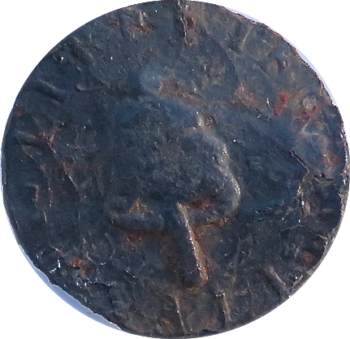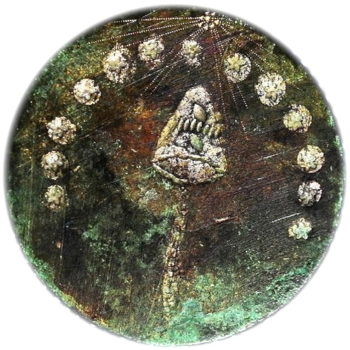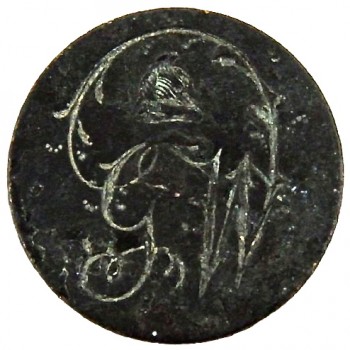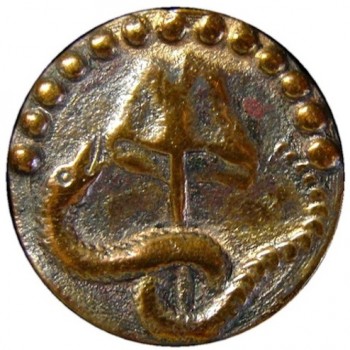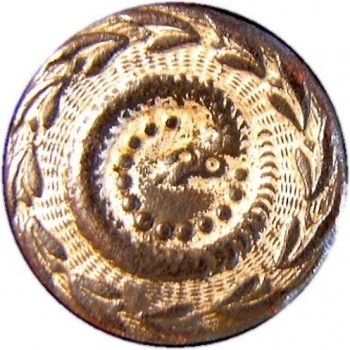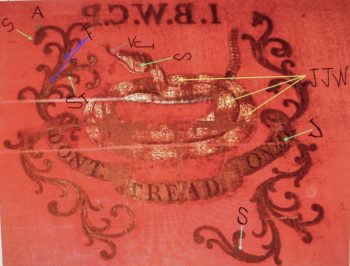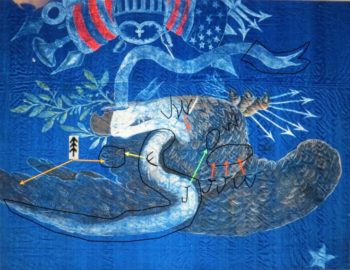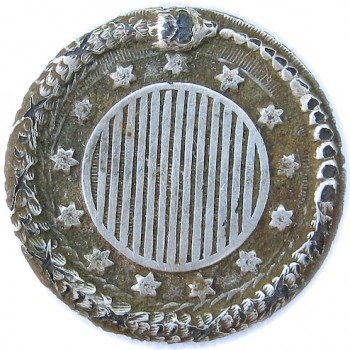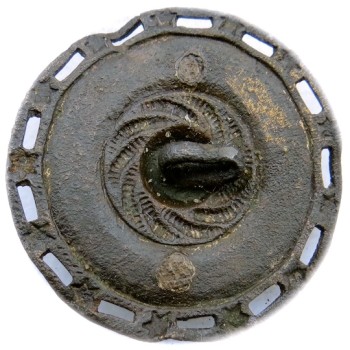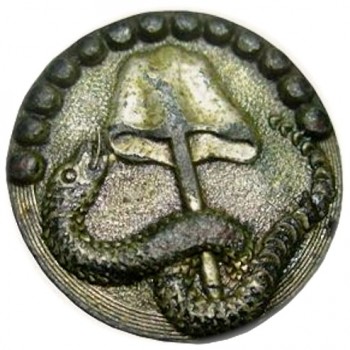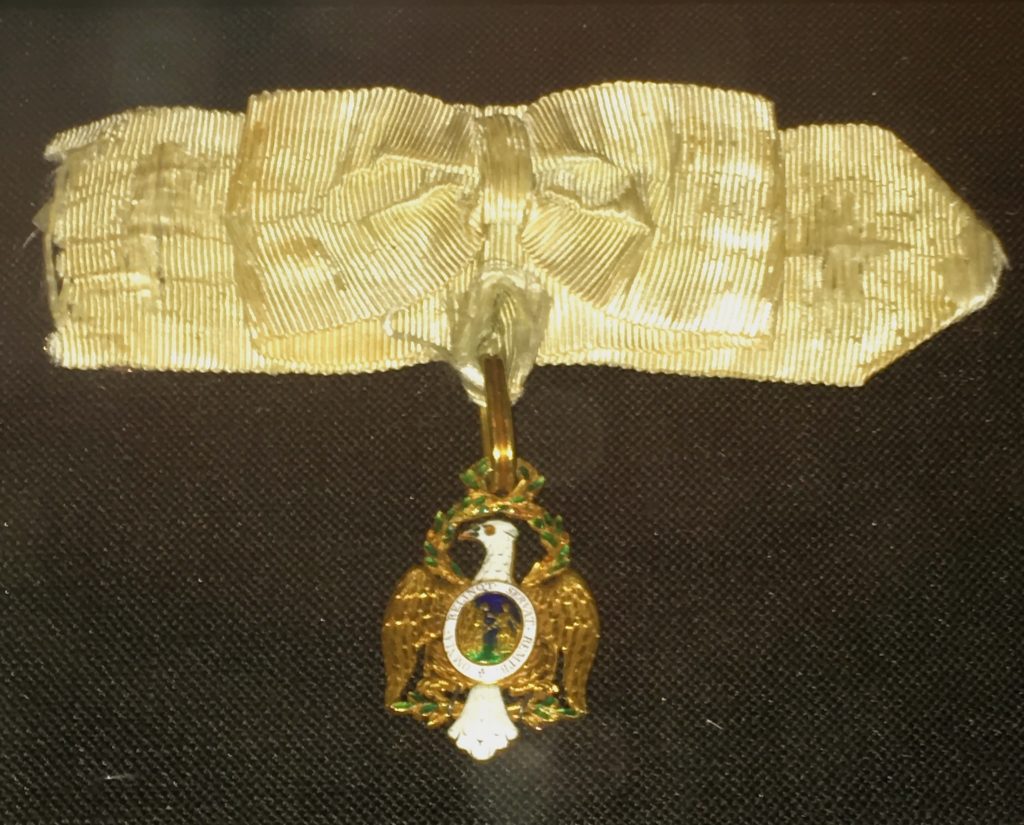by
Robert J. Silverstein
18th Century Jacobites & Scottish Royal Culture History
******** ***** ********
Co-Contributor
Dale R. Hawley
Judaeo-Christianity & Ancient Symbols Meanings
************* ************* **************

1792/5 Philadelphia Rattlesnake Allusion
2 Baby Rattles in the Mouth showing Vermont & Kentucky
entering into the unification of states
Made with the foresight of the War of 1812
************* *************
Scottish Royal Culture & Judaeo-Christian Re-Purposed Propaganda
************* ************* *************
*
The Revolutionaries of the Old World Order
LI BER TY
*
The Sons of Liberty Red & White Stripe Flag, * Liberty Cap buttons, * Rattlesnake Buttons & Flags, * and George Washington Inaugural buttons were all different mechanisms of Revolutionary Propaganda. For our 18th Century American colonists the symbols all carried the same underlying message of Liberty and Independence. One that was away from the Parliament and Crown’s tyranny suffocating laws. The one underlying historical take-away is that all of histories symbolism was transformed in context use and Re-purposed into Propaganda to fit the Revolutionaries narrative. This was not a quick transformation of messaging as one might think, but one that was developed over time through a manifestation of breaks in social contracts. The transformational messaging was worked-on over a number of years by disgruntled American colonists in the Patriot movement (Sons of Liberty & Various Committees of Safety, ect..), and earlier mid-1700’s grass-roots underground movements in England, France, Italy, and Scotland.
-RJ. Silverstein
*
The Beginning Symbolism & The Aftermath
*
After Caesar’s death, Mark Antony staged a grand funeral for Caesar. The dictator’s popularity was such a dissention that a riot developed in Rome. This led to Caesars impromptu cremation in the Roman Forum. Some of the assassins, including Brutus and Cassius, took this as a cue to leave Rome, though they never gave up their official positions. The remaining assassins put a “Positive Propaganda Spin” on the events, celebrating it as an end to tyranny. (The Revolutionaries Goals to a Republic) An amnesty was negotiated – though a Senate agreement (Continental Congress & British Empire) to ratify all of Caesar’s decisions. A new coin was minted, showing two daggers and the “Pileus”, the Cap of Liberty worn by freed Roman slaves, which was the Populus of the Roman Republic. (Colonists freed of British Rule). Symbol Transformation of messaging to fit History’s Eras’ when social contracts are broken. Egyptians had freethinkers who wrapped their heads in caps, Bastille Day in 1789, for the French Revolution- all used Liberty Cap as a symbolic message of freedom from tyranny. All cultures Re-purposed the symbolic imagery to fit their propaganda messaging in their revolutions of social contracts. All called for a New World Order…. One of Freedom & Self determination.
-RJ. Silverstein
*
The Stargate Arch of Sovereignty * Sirius, The Dog Star * The Honey Bee
13 States W/ 5 Pointed Stars Represents The Brightest Star in the Sky This is a Biblical Reference
America taking its “Rightful Place” Shinning down on the New Republic. for the Devine Right of Kings
in the Celestial Heavens as other Sirius in the center, 7 for God & his workings, through the House of Stuart via
established worldly nations have. 3 for Biblical Patriarchs: Abraham, Isaac, & Jacob. the Merovingian King bloodlines
* * * *
* God’s Love shinning down on America through the Scottish Royal Bloodline *
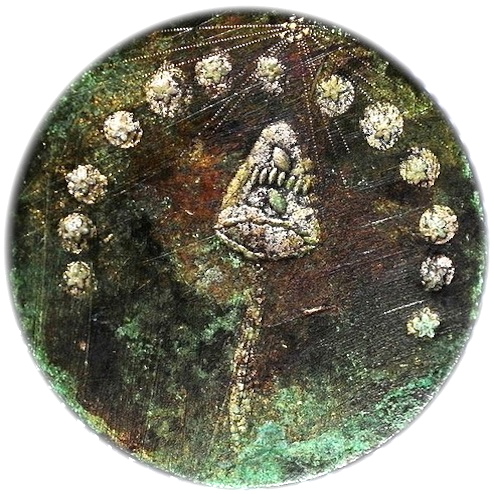
Scottish Royal Culture & Devine Numbers
* 3, 5, 7, 8, & 13 *
The Jacobite Uprising of 1745 The Honey Bee’s Body
Prince Edward Stuart used the This is both a Devine link to God
Liberty Cap & Pole in a printed and a reference to the 7 Earls of Scotland
propaganda campaign aimed at and the Wings are the King and Queen of Scotland.
Scottish Clan leaders & European nobles
for the Restoration of the House of Stuart.
*John Morin Scot was the 1st person in America to stake a Liberty Cap & Pole in the City of New York as a Rebellious propaganda symbol for the Sons of Liberty messaging. John M. Scot’s lineage has direct ties into the House of Stuart bloodlines.
The New World Order
There was a grass roots movement among the newly landed gentry in America that would flourish into a bridge between the established aristocracy of old wealth, and university elites. This bridge would take form under a new founded Patriotism / Nationalism of the American Revolutionary movement. These were men of America’s rising class were tired of being on the short end of established social contracts between the age old established governments led by religious leaders, monarchies and their nobles. The Enlightenment movement offered New Enlightened Ideals that originated in Scotland’s Universities and then branched out into Scottish and England’s aristocracy. Soon other European neighboring countries saw the social contract benefits of these new Ideals it questioned the individuals relationships with God, and their unfettered independence of Prosperity, which was away from established government social-political-economic contracts. These progressive revolutionaries with their New Enlightened Ideals of social contract change would take a grass-root movement in English, Scottish, French, and in America’s Social clubs in the 1760’s & 1770’s. This would lead into the American Revolution. These organized Revolutionaries (as part of the Sons of Liberty Organizations) were looking to reform British established political-economic-social contracts into a new kind-of social construct calling for a “New World Order,” which was a societal move away from Devine Rights of Kings to Individual Responsibility for ones own actions and relationships with God.
*
We could we reasonably say with some assurance that all Liberty Cap & Pole buttons consistently carried a consistent propaganda message of Liberty and Independence regardless of which countries used it in their Rebellion. Even though other contemporary countries such as, Argentina used this symbol for their propaganda messaging, we can still credit its origins to the ancient Egyptians and Romans. For 18th century America and France i would have to give credit to the House of Stuart Royal Family Civil War with the establishment of the Hanover Monarchy of George I of Great Britain around 1698 to 1700, just after Ernest Augustus the elector of Hanover died. The Phrygian Cap and Pole was first re-introduced by George I in his propaganda war against the King James II & VII of Scotland & England in his attempt to regain the throne of England after his dethronement in the Glorious Revolution in 1688. This was a propaganda campaign which was targeted directly toward the Sir Knights of the Order of the Garter, and the English Nobles of Court. He cleverly used the ancient Phrygian Cap & Pole symbol as a persuasive measure to wrestle control away from Scottish and English supporters who believed in the Devine Right of Kings; and supported the natural restitution of James II & VII after the death of William III of Orange & Mary II.
The Liberty Cap and Pole was then re-used by Prince Edward Stuart and turned back against George II the Hanoverian King of England in 1745/46. The Bonnie Prince used the Phrygian Cap and Pole in an active propaganda campaign to unite the Scottish Clan families out of power in-order to reinstitute Prince Edward Stuart back to the throne of England. After the Bonnie and Clan Army lost at the Battle of Culloden in 1746, fleeing members of the Scottish Royal Court loyal to the House of Stuart fled to France and Italy. Having found sanctuary in France, Jacobite sympathizers continued an undercurrent movement against the King of England which spread throughout parts of Europe and within England’s High Society Social Clubs. The Scot’s War never died, but hibernated in Scotland, England, and France and slowly blossomed into a geographical disenfranchised underground movement utilizing members positions of power in society and media campaigns against the King of England.
The French inscription was a twist until you take into account that Scottish Heritage Gentry in America did come by way of France.
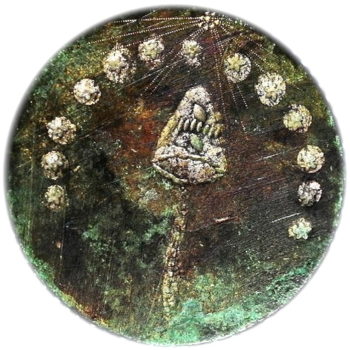
1760’s to 1770’s Scottish Royal Liberty Button
Color: A Charcoal Green with Silver Highlights.
Metal: Flat, 1-Piece, Impressed Design of Bee then Hand-Engraved Silver-Wash Copper.
The Size: 32mm. Coat Size.
Rarity: R-7 (1 known) Strict Observance Scottish Revolutionaries.
Variety Type: Jacobite Liberty Button / Eye of Providence / Honey Bee /13 Stars to Represent Colonies.
Present Condition: An Excavated Specimen, A Strong Planchet Condition Remains, A Strong Impression Remains.
Robert’s Notes: This is a Scottish-Rite Lodge fraternity button most likely used by a Jacobite who was a member of the Revolutionary Sons of Liberty organization. The button was most likely worn only in a Masonic lodge to show support for the restoration of the House of Stuart. This particular button was most likely made for a specific lodge member who is part of the Royal Bloodline families to the House of Stuart (Prince Edward Stuart). The Bumble Bee within the Liberty Cap represents the “Devine Right of Kings” of the Stuart family by way of the Merovingian King lineage to Jesus. Above the Liberty Cap is a “Stargate Arch” with thirteen (America) 5 point Stars signifying its place with other established nations in the Celestial Heavens. Sirius the brightest star in the night time sky shines down on the Jacobites New Republic. The Liberty Cap & Pole was used in a printed propaganda campaign or restoration of the House of Stuart by the Young Pretender in 1745/46. It was aimed at Scottish Clansmen who’s lineage was barred from political & economic power by the Hanoverians since the Glorious Revolution in 1688. This movement continued on with Scottish Gentry in America and known on both sides of the Atlantic as a generational Scots War. This button symoolizes how Scottish families discreetly played chess through freemasonry against George III, and used Jacobite sympathizers through vehicles of the media and social clubs to move their agenda in the restoration of the House of Stuart. Prince Edward Stuart to regain the Crown in America?
This Scottish Liberty Button was found on a Revolutionary War homesite on the River Terrance in the City.
General Murcer’s mother in-law’s property was sold to Washington’s Nephew, then later owned by Robert Scot’s son Robert Scot JR Private merchanter / Ship Captain.


1760’s to 1770’s French Design Sons of Liberty Button “Liberte All”
Color: A Charcoal Gray with an Ochre of Red Highlights.
Metal: Flat, 1-Piece, Pewter Mold, Raised Design.
The Size: 20mm. Vest Size.
Rarity: R-7 (1 or 2 known) Most Likely Virginia Freemason Revolutionaries.
Variety Type: American Revolutionaries (Sons of Liberty Liberty) Cap Button / French Design / American Made / Southern State Variant.
Present Condition: An Excavated Specimen, A Good Planchet Condition, A Good Raised Design Remains.
Robert’s Notes: I believe this vest size button belonged to a member of some kind of Sons of Liberty Organization in Virginia. Robert Milburn pointed out to me that Norfolk Virginia SOL’s were very active revolutionaries and i would have to agree. Unfortunately, we can not give an exact provenance, but we can tightly date the button’s construction within ten years. We do have several clues to help give us an educated guess based on it being a molded pewter button which is consistent with American made construction. We also know that American Sons of Liberty Revolutionaries were in Rebellion during the late 1760’s through the mid 1770’s. The French inscription was a twist until you take into account that some Scottish Heritage Gentry in America did come by way of France. Could it have been silvered at one time?
Robert J. Silverstein’s Isabela Collection.
Dug by Packy S. along the Appomattox River Sept 18, 2018.


Late 1760-1770’s LI BER TY An American Citizen Revolution Button
Color: Dusty Gray.
Metal: Flat, 1-Piece, Pewter Mold, Raised Design
The Size: 17mm. Cuff Size
Rarity: R-7 (1 of 2 known) Dug Together
Variety Type: American Revolutionaries (Sons of Liberty, Committee of Safety, ect..)
Present Condition:An Excavated Specimen, A Good Planchet Condition, A Good Raised Design Remains.
Robert’s Notes: I believe this vest size button belonged to a member of some kind of American citizen Revolutionary Committee formed against British injustices in Upstate New York.
Gary Noon Dug 2 in Ghent New York 04-30-21
*** ** *** ** *** *** ** *** ** *** *** ** *** ** ***
*** ** *** ** *** *** ** *** ** ***
***
 The picture above tells a story of how Jacobite sympathizers in England, and Free French Forces join America’s Rebels against the Crown of England in an attempt for a social contract change.
The picture above tells a story of how Jacobite sympathizers in England, and Free French Forces join America’s Rebels against the Crown of England in an attempt for a social contract change.
RJ. Silverstein Collection


1478 drawing of an Alchemical Tract, by Theodoros Pelecanos.
Alchemy was the ancient branch of “Natural Philosophy.” A Philosophical and Protoscientific
tradition practiced throughout Europe originating in Greco-Roman Egypt in the first few centuries AD.
Rattlesnake Propaganda Messaging in a Nut Shell
The Rattlesnake Buttons of the Revolutionaries
Rattlesnake Buttons were made in both England and France. To date (2019) there have been three Rattlesnake buttons dug in England all approximately one hour travel outside of England. To appropriately grasp and take-in the era, Rattlesnake button collectors must understand the American Revolution was known as a “Scot’s War” on both sides of the Atlantic. America was nothing more than an Address for Great Britain. In Scotland’s Universities and England’s social clubs during the 1760’s there was an underground movement that worked against the King of England. They provided a new movement dubbed the age of Enlightenment. They put forth “New Ideals” which tried to change and fade back centuries of Devine Right of Kings rule and Religious hierarchies of power. In Scotland, university professors would wield their influence on graduates and aristocrats who were sympathetic to their new views of change. In England it was slightly more underground using social clubs who’s members were in political positions of power for the King and country by the day, and then secretly meeting at night airing their disgruntlement with the throne and planning how to topple the established societal contracts by which people live by. This is how we tie all this in for the Scottish Jacobite undercurrent of the American revolution. If we follow the dethronement of King James II in 1698, it leads to a progression of wars in Scotland and England which continued on to a finality in the American Revolution. Jacobites must be accurately depicted as the basis for providing New Enlightened Ideals, Constitutional Freedoms, and Cultural Symbol Tributes. These three factors were allowed to culminate and work “more openly” in the British colonies who’s European colonists felt a detachment to the overseeing monarchy. Flash points of social contracts would occur producing a citizen based Patriot movement that would give way to a post war American nationalism. These Revolutionaries who met in neighborhood Masonic Clubs and taverns would become Revolutionary Patriots and their Bade was the American Rattlesnake button. The one important note about Rattlesnake buttons is that their designs catered to all European nationalities in efforts to be inclusive in the struggle for independence.
*** ** *** ** *** *** ** *** ** *** *** ** *** ** ***
A:1 British Design A:2 British Design
* Dug in America only Found in Great Britain & America


There appears to be a slight design difference in both Rattlesnake buttons, but from it’s construction one can reasonably imply they were both made in England. There is a third design only found in America which the snakes head is in reverse and uses the designs of the American pointed stars. Collectors can reasonably assume that certain design patterns were fabricated by more then one manufacturer. Meaning, France could have designed a more American Pointed Star to cater to the Revolutionaries in the American market while the traditional English stars were catered to Americans as well as Englishmen who were Jacobite sympathizers in the British market. The fact remains that all Rattlesnake designs were sold to Revolutionaries who worked on opposite sides of the Atlantic to usher in a New World Order of individual liberty and personal responsibility for their own prosperity. This was a transatlantic underground movement which moved away from the Devine Right of Kings and religious hierarchies of power.
B:1 Scottish & British Integrated Religious Design B:2 British Celestial Design
* Dug at the home of Brigadier General Augustas Washington. Found in Great Britain
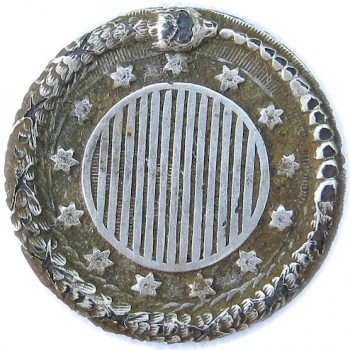
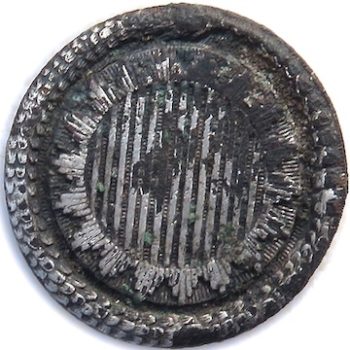
B:3 British Religious Design B:4 British Design
Dug in Great Britain Dug in America


B:3 Since this button was dug in the United Kingdom on the river banks of Strood (the unitary authority in the medway of Kent in the south east of England), it serves as clear evidence that British & French artisans re-purposed Scottish & English history of Charles I &II Resistance and Restoration as propaganda to fit the American Patriot Cause. Meaning they transformed or morphed the serpent devouring its own tail analogy into America’s indigenous Rattlesnake somewhere in the 1760’s-1770’s.
Next, is the transfiguration of the meaning of the Chain Link. This pattern was said to be the idea of Benjamin Franklin for early currency such as the 1776 Continental Dollar or the later 1787 Fugio Cent. This is not the truth by a far stretch. This was actually Re-purposed Propaganda again such as, the Liberty Cap and Pole, or the American Rattlesnake Buttons. This again drives from 18th century England around the 1760’s I believe with the underground Jacobite movement against the Hanoverians. As with the 1760’s Eternity Snake below it shows a united front against the Hanover King and his Order of 12 Knights for the Restoration of the Rightful Stuart King. Under the Patriot Allusion of the “13 States Uniting Together,” Robert Scot & his Philadelphia Artisans were able to use sort-of-an evolutionary process of the “Old Serpent of Resistance” taken from Charles I to Charles II reign. Cleverly, they were able to transfigure the Ouroboros symbol into a New Chain Link Symbol. On one front it provided the American citizens the Allusion of a Unity representation. While it’s substructure of a completed linked-circle inferred to the meaning of the English use of the true Ouroboros meaning,”Time is Renewed” and the (chain link) circle is now closed for the rebirth (of the New Republic).
B:2 the struggle in america during revolutionary war period. the design implies unity with the Catholic French
Jacobite’s of Scottish decent that left Scotland and resettled in France
C:1 Scottish Royal Culture Undertone, English Design
* Dug in the United states
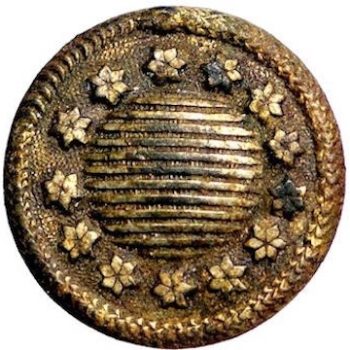
C:1 I see God’s number “7.” This would be a religiously motif Rattlesnake button hereby integrating Scottish Catholicism into America’s religious fabric of English Christianity. While English & German Anglo-Saxon Christian Patriots see thirteen 6 petal flowers in reference to the states, Scottish Jacobites see the the petal’s shape as the Regnal Jewels of Scotland. The Bonnie being “6” and the right-hand-of-God. While normal on-lookers see normal ordinary flower petal crosshatches, religious Jacobite Revolutionaries would see all roads lead to God in the “center” revealing his number “7″. While European American Patriots see 13 stripes for the unification and identification of the 13 colonies, Scottish Jacobites see a dome representing the rising or raising of the New Republic flag free of Devine Right of Rule. This is not the old representation of Prince Edward Stuart and the Order of the Garter (13) “English Bars”, but being the rise or more accurately the “Restitution” of the Scottish Royal families ascending back into power in America’s New Republic.
*The transfiguration first into Rattlesnake Buttons and then later into America’s New Federal insignia was done by using Scottish Royal Culture’s Authority and Devine Rights as the “underlying fabric” in America’s New Republic. This was an “Unpublicized Measure” taken in-order to end a century of transatlantic “British Scotophobia” produced by the proactive propaganda measure taken by the Hanoverian Devine Right to Rule in a “Societal Indoctrination.” -R.J.S
D:1 Scottish-English Design D:2 British Design


D:1 This is a Scottish-English design paying tribute the Prince Edward Stuart via the Devine Right of Kings of the Bethlehem Star that coincides with his December birth star he was born under. Since the evangelist Mathew does not tell us what the Bethlehem Star looked like; what color it was or exactly how many rays came from it; 18th century religious figures usually gave mans affiliation through five or six points even though Christian symbolism attached to the star could be 4, 5, 6, 8, 9 and 12. Four Point Star is the Natal Star representing Jesus Birth. Five Pointed Star mathematically known as a “Pentagram” with one point aimed at the heavens symbolized the 5 wounds of Christ. The Six Point Star known as the “Creator Star” recognizes Jesus’ Jewish origins and God created the world in six days. The Eight Point Star recognizes Mary’s birthday and her Immaculate conception. The Nine Point star reminds us of the fruits of the Holy Spirit: Love, Joy, Peace, Patience, Kindness, Generosity, Faithfulness, Gentleness, and Self-Control. Last is the 12 Point star which brings to mind the 12 Apostles as well as the 12 Tribes of Israel.
D:1 & D:2 The thirteen bars represent a multi-layer allusion of tribute to America’s 13 States Union for independence; The Scottish or English King of England and his 12 Sir Knights of the Order of the Garter / Thistle; Jesus and his 12 Apostles.
D:1 Dug in USA, French Design D:2 Dug in USA, French Design

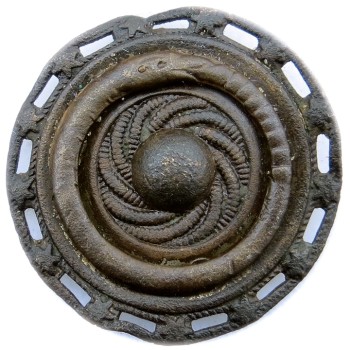
Multi-Allusions Working in Concert
RJ. Silverstein Collection
The Fleur de lis in the center means France is in the middle of the Scot’s War and acts as a shield against the British while showing support for the 13 colonies for their independence.
You should be tasting sweetness from the fruit provide by the tree look within the examples and you will see the serpent. This should make an interesting addition to your rattlesnake section if you get the whole picture.
Satan and God as represented by the numbers 6 & 7 and these two numbers bookend our reality I find it interesting and you should also that the center of the Fleur de Lis lands on the 7th bar silhouetted by 6 bars on each side and of course the bottom of the Fleur De Lis has three prongs similar to the broad arrow mark. A gift back to you.
The number 10 used in the tail rattles for the French Rattlesnake buttons has several layers of religious Allusion. For our French freedom fighter revolutionaries it most likely symbolized the completion of the cycle. The number has several religious significance throughout the Old Testament and Bible. Ten was seen as the number of Heaven and the World in terms of Universal creation. Since, 10 is the first number that requires a separate part it reflects how everything has an opposite working against each other in-order for one to work properly. Meaning, the number 10 symoolizes and represents a complete and perfect number. In religion ten could be broken down into its significant parts. The number four is the number of physical creation, and six is the number of man. In its combined conclusion 10 would mean testimony, law, responsibility, and the completeness of worldly order. In an overlay, God gave man the 10 Commandments; Therefore 10 represents mans responsibility to keep those Commandments. In Genesis 1 the earliest introduction of the number 10, God said ten times, which is a testimony of His creative power. In Exodus the Passover Lamb was selected on the 10th day, and the Lamb takes away the sins of the world. In Tarot the Ten card represents the Wheel of fortune and the Wheel symbolize the beginning of a new cycle. Plus lets not forget Virginia was the 10th state admitted to the union of June 25th 1788….lmao
*** ** *** ** *** *** ** *** ** *** *** ** *** ** ***
PR:1 New Republic, Scottish Masonry Undertone PR:2 New Republic, Scottish Masonry Undertone
* Commonly Found in Northern United States Commonly Found in Southern United States
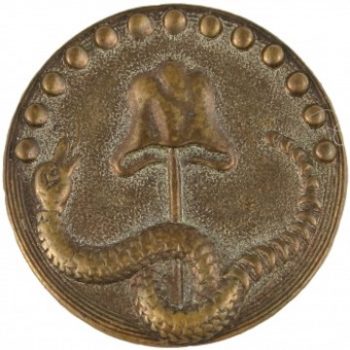
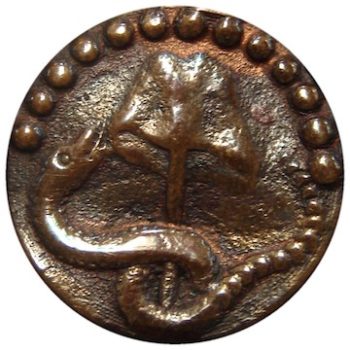
PR:2 This is a Masonic Jacobite Tribute Variation who’s design artistry most likely originates in Philadelphia under Robert Scot’s umbrella. The Rattlesnake’s head is an exact replica of the Philadelphia Grand Lodge Flag. The sister variant C:2 with the Rattlesnake wrapped around the pole depicts a more snake head depiction without Scottish Royal Culture tribute. The Phrygian Cap motif was taken from Prince Edward Stuart’s propaganda use in 1745/6 uprising. The snakes body coiled around the pole illustrates the 18th century British Royal Family Civil War between the Scottish and English family members of the House of Stuart. Both sides of the family claim the Devine Right to Rule over Scotland, England, and Ireland. The divergence begins in 1625 with James I of England & Anne of Denmark son and daughter’s destinies. It would be inappropriate to give American Patriot Rattlesnake buttons liberty cap & pole proper affiliation to the Roman Senates earlier use. The Bonnies propaganda use toward “usurper” King George II during the Jacobite Clan uprising in early 1745 did however. The 13 Cosmic Eggs form in a Celestial Arch over the Rattlesnake, Liberty Cap & Pole. This is a Scottish-Rite affiliation from ancient Scottish Royal Culture history often referred to as a Masonic “Star Gate” or “Star Arch.” This is a direct reference to the ancient belief of man’s true origins lie in the stars.
Since, most people of their inherent nationalities automatically recognized their own history of the symbols they saw depicted in these buttons maybe it might be best for me to provide a demonstration (C:2) instead of me giving historical information of the symbols.
RJ. Silverstein’s Clockwise-Counter Clockwise Proposition: There could be some undercurrent messaging by artisan designers who were trying to capture the political feeling held by disgruntled Jacobite’s in England’s social clubs for the Hanoverian rule. The counter-clockwise would represent the Hanover Dynasty’s (King=1) rise to power through his Protestant religion who was politically maneuvered into the leadership over the (12) Sir Knights of the Order of the Garter (1+12=13 Rattles). The Clockwise design would represent Scotland’s Prince Edward Stuart who is the rightful Catholic male heir of the House of Stuart, and legitimate leader of the Order of the Garter. I only put forth the proposition because political buttons usually contain subliminal messaging with a specific intent or purpose. This does not mean that this proposition applies to all Rattlesnake designed buttons either. My purpose is to make you think and understand the social political environment in-which the buttons were created.
PR:4 America’s New Republic, A French Design PR:5 America’s New Republic, A Scottish Design
* Post Revolution Post Revolution

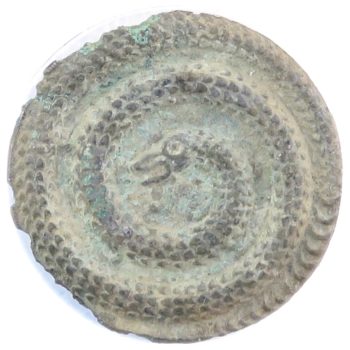
PR:1 & 2 This would be one of the first designs moving away from the Charles I & II Resistance and Restoration motif of the snake devouring its own tail. The idea was to capture America’s embrace of the New Age of Enlightenment, which was taking hold in America’s New Republic. With the Enlightened Era’s New Ideals which were backed by natural science and some basic individual freedom & liberty principles drafted out of the Masonic Constitution; we as a people would be able grow and break the shackles of the Old World Order and create a new society of equality. Rattlesnake designs moving forward out of post-revolution (as early as 1779) will no-longer reflect the snake devouring its own tail.
PR:6 The New Republic 1792, Scottish Design Found in a Park in Philadelphia, Pennsylvania.
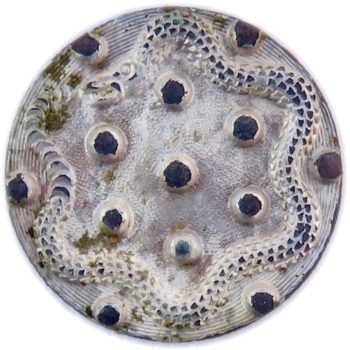

PR:6 This is a Scottish Royal Culture tribute design which was made approximately 10 years after the American Revolution. This is the only rattlesnake design that depicts two small teeth in the rattlesnakes mouth, which acts as a reflection of the creation, infancy, and admission of the first two two new states outside of the original 13 (Vermont (14) and Kentucky (15)) into the union in 1792.
There are many allusions at play that work in concert, but all have a Scottish Royal Culture tie which provides a Jacobite related undertone. The six cosmic eggs on the outside would be the religious layer reflecting the Bethlehem Star of Jesus in the celestial heavens (above). This correlates directly with Prince Edward Stuart’s birth star in December of 1720, and the underlying premises of his birth and Devine Right to rule as the right hand of God. The seven inner eggs is a reflection of man (below) and reflective of the Jacobite origins steaming from King James VII. and religious incorporation of God’s number “7” in the center working through man. The Rattlesnake itself is another multi-meaning overlay. First, by the Rattlesnake not eating its own tail it signifies the movement was past the Resistance and Restoration century old struggle. The Rattlesnake not devouring the 13 rattles can also signify the break of the King of England and Order of the Garters control over society. Second, The shape of the rattlesnakes body reflects the Bonnie Prince’s 5 Petal White Rose, which was emulated by the Scot’s during the Jacobite uprising of 1745/6 and the American Revolution. By providing a false tail rattle it reflects the undercurrent support of Scotland’s Prince Edward Stuart from Italy and France.

*** ** *** ** *** *** ** *** ** *** *** ** *** ** ***
With some historical information on key figures of the era by Dale Hawley and Gary Gianotti i was able to capture the 18th century thinking of the world’s elite class, and how they maneuvered and positioned themselves their interests to work in their benefit and expense of society. The Revolutionary design artisans who lived under class stratification understood their position in life and clearly made tribute to these wealthy individuals in their artistry. They designated certain signature marks or depictions to these Royals and nobles that were undisclosed to the general public.
The Hawley Proposition
In the diagram above there is evidence that the artisan of the Rattlesnake button gave tribute to the Jewish Rothschild family by using Solomon’s Seal as a hidden tribute within the 6 point pentagram design. By using the Hebrew Star incorporated with the Rattlesnake design it sub-meaningly displays the gratitude for help during the Revolution and Post-Revolution. By using a 6 point Hebrew star it directly spoke a message to the Rothschilds family members, Red Shield members, and illuminati.
The Rothschild Family Coat of Arms uses all five colors as illustrated in the Jewish Star in the Graph. Each represents a brother that had helped America’s New Republic in gaining stability. The black star in the overlay represents the Dark Prince. This is the Rothschild brother who benefits by working against America’s New Republic because it is in his monetary advantage to do so. This comes in many forms from benefiting from America’s entrepreneurs or foreign interests of rival market competition. For young Americans trying to build a nation it was like a wielded unseen two edge sword by a family of seasoned veteran capitalists who had the right worldly connections and societal status. Not all Americans were blind. The Scottish Gentry of old money as well as members of Washington’s Administration clearly saw the manipulation and were caught in the middle of the principles of the Grand Architect’s Design of a new societal construct and their poor country’s need for the support of these world elites. The Red Star would be the representation of the Rothchilds family member’s actions through the Red Shield of the Illuminati.
The artisan design pays obeisance to the Rothchilds family for their in-direct monetary support for the Patriot cause during the American Revolution. In Gary’s view, the Scottish Gentry connection would be Lord Drummond using the Rothschild family as a false front in lending America money via by the Sinclair bank in Italy. It is a portion that is hard for me to research and prove, but is worth noting. The multi-layer five star design demonstrates a level of noted appreciation to each the powerful world’s players in an auspicious religious manor to the Rothschild Jewish religion.
Each one of the stars represents an appreciative tribute to the workings of their emissaries. This would include the Rothchilds-Red Shield members, illuminati constituency, and American Patriots who worked behind the scenes to change the societal construct into a working system ( New World Order) that would be free and able function from the Devine Right of Kings and social contracts of their governmental rule. The design of the button was an inconspicuous way the American Scottish Gentry who were in the era’s economic power were able to signal they were “keeping the door open” as a welcoming mat for the future financial support that was desperately needed in America’s post-revolution era. They understood the countries desperate need for monetary tools in banking and venture capital to build a solvent nation on the world’s stage.
The Rothchilds support the Patriots in the USA at the same time as they were provide funding for England and Germany.
“Rothchild-Red Shield Illuminati financing the war against the “King of England” To the trained eye, we are saying this war is fought behind the veil of normal diplomacy between 2 kings playing chess. The world looks at the chessboard itself, instead of behind the scenes. To control America’s resources from the earth’s mining and trees. As all perceived Gods use religion for kings they embed their symbols with high morality religious means.

* Rattlesnake Design Key
British Design: Resistance & Restoration of Charles I & II. Ancient European Alchemist Philosophy coinciding with Religion on man’s inherent nature of self serving weaknesses and how its effects on one another.
Scottish Design: Scottish Royal Culture and it’s tributes to ancient Greco-Roman symbolism. This can also be viewed as having an overlapping with British design pattern by way of Prince Edward Stuart through King James I of England via Merovingian King line to God /Jesus Christ.
America’s New Republic Design: Undertone of Scottish Royal Culture ushering in the New Age of Enlightenment and move away from the Old World Order of Devine Rights of Kings.
Celestial Star Pattern: Was used to denote the proper place in the heavens next to God. Masonry correlated it with man’s origins, and wealthy families used it as a Coat of Arms for their Flags on merchant ships. Also, during and post-revolution the star was correlated with the design shape of round eggs to denote the 13 states infancy.
The Rattlesnake Devouring its Own Tail Motif: Originating in Alchemy during the early Greco-Roman Egypt period went on to be used as a propaganda tool during Charles I & II reign of power to denote Resistance & Restitution. Later used during the the Jacobites in their British Civil War and continuation into the American Revolution.
The 13 Stripes or English Bar Pattern: The stripes represents the 13 states unified for the Patriot movement. The 13 English bar pattern represents the King and the 12 Sir Knights of the Order of the Garter. Religiously, the 13 represents Jesus and his 12 Apostles.
“Liberty, when it begins to take root, is a plant of rapid growth.” -G.W.
************* ************* *************
************* * Preface * *************
To help understand the concept of the 18th Century’s New Era of Enlightenment Ideals in America, I will offer a King’s analogy below to help people widen their historical lens in order provide the proper context of 18th Century Scottish Enlightenment. Understanding the dynamics of a societal revolution toward established societal constructs has many pieces. One has to account for 18th century contemporary views of social contract philosophies through European universities, while balancing the need of the people to actually take an active role in changing the established governing authority. The new societal construct of the “Grand Architects Design” which was ultimately offered by the founders allowed for the society transformation through the earlier on-going established movement of the Jacobite cause. Indirectly, by the educated class of gentry class there was a push to use the Jacobite tool box as an undercurrent pin and foundation for the Patriot Cause.
Premeditated Jacobite pieces from Scotland and England with their own secret agendas like Scottish Artisan Robert Scot was able to take advantage of the Revolutionary movement as a deceptive front, and incorporate their on going agenda under the Patriot Cause. The Jacobite Cause has become so intertwined that one only has to separate out certain elements to make it the American Revolution instead of the Jacobite Revolution. Understanding how these Pro-Scottish Revolutionaries were able to help transform society through the new Ideals of Enlightenment, and then collate multi-culture nationalities by using common cultural and religious denominators will be reflected in America’s new federal insignia.
+By being able to infuse their artistry with established House of Stuart authority and divinity it provided the Federal government’s foundational framework for a world stage sovereignty; Also by providing Scottish Royal Culture Judaeo-Christian roots it provided a “timeless framework” to all nationalities of the Patriot movement, and then circled into the fruits of a New Republic by the representation of it’s citizens.
The Grand Architects Design was implemented through of artistry of Robert Scot by him acting as an “International Guild President.” He would be the only one permissible by the Scottish family factions (Bank of Scotland / Italy & Pope) who they could entrust to carry forward their plans for the restoration of the House of Stuart in America. Robert Scot was one of only a handful of artisans in the 18th century who would have had the proper skill, authority, knowledge, and “permission” to use Scottish Royal family culture and Divinity (“E”) symbols within the art he produced. There would have been no-one else in the United States which would have had this kind of specialized training and knowledge with authority to use Scotland’s House of Stuart Royal family artistry symbols.
Robert Scot’s Transformational Art Technique through the use of Allusion provided a way for the Revolutionaries to infuse the Patriot’s Cause with the proper winning tools on a Macro-Propaganda Scale, and then again to re-use later as a symbolic weave of symbolism in the foundation stones of the New Republic. Finding an origination point of a symbol such as the Phrygian Cap & Liberty Pole, Rattlesnake, Zoroastrian Phoenix / Eagle use in history is very, very complex. We can not just point to a first or second time use and then bring it forward to give a specific meaning and context to the use of the Revolutionaries scheme under the Grand Architect’s Design. Meaning, historical use of certain propaganda tools changed through history to fit the time and the context of each use. We will now use the term, Re-Purposed Propaganda when we denote the Snake, Phrygian Cap, Liberty Pole, the number “8”, “13”, Liberty Tree-Oak, and Rattlesnake-tail. Judaeo-Christianity symbols will include the all the Numeric Values of God, the “E” Divinity symbol of Charles I the Confessor, the Star of David, and the Christian Cross for George Washington Spy buttons.
Strict Observance Freemasonry
The Bonnie’s Jacobite
Allegiance Liberty Button
A simple example of Re-Purposed Propaganda would be the Liberty Pole & Cap. The first recorded use of the Phrygian Cap would be by the Egyptian culture 3000 to 300 B.C. when the religious and mathematical scholars protested against the Pharaoh by wearing a Phrygian Cap. Semi-paralleling around 100-44B.C., the Roman Republic’s Senate transformed and integrated the Phrygian Cap into a political statement with a standing pole in their revolt against Caesars tyrannical rule. Then in a struggle for power between Hanover’s German decent George I of England and James II of Scotland it was re-introduced. Then in the mid 1740’s, (the incorporation of these two symbols 1st time) was re-used by Prince Edward Stuart of Scotland back at the Hanoverians of England. The Bonnie “Re-purposed” the propaganda but changed the use of the context for House of Stuart Jacobites against the British Royal families stranglehold on positions of power. The Bonnie Prince Charlie’s context would be the proper one to reflect where America borrowed this propaganda context of revolt. A relative of the House of Stuart John Morin Scott who was a founder of the Sons of Liberty and A Brigadier General for George Washington “Re-purposed” the propaganda statement again to the same oppressors and staked the 1st Phrygian Cap and Liberty Pole in the City of New York. This re-purposed propaganda of the Phrygian Cap & Pole transformed into the Liberty Cap & Pole which turned into a popular form of “expression” by the citizenry for 10 years. Disgruntled citizens with the Proclamation of 1763, the Sugar Act of 1764, and the Stamp Act 1765 would purposefully stake wooden Liberty Poles in the ground throughout the colonies as a political statement for more then 10 years. This originated with the British Stamp Act in 1765, and lasted throughout the American Revolution.
1789, George Washington Inaugural Button
with Jacobite Tribute to the Bonnie Prince
More importantly, the continual re-introduction of these re-purposed symbols in history would provide a constant contextual meaning of Liberty as the common denominator with little change in context use toward the oppressor. Meaning, it would be indifferent who used it in their struggles for independence the meaning stayed the same. From the 1st contemporary use by King George I around 1712 to 30 years later in the 1740’s with the Bonnie Prince Charlie, and then again in the 1770’s by the Patriots in America. We believe the Liberty Cap & Pole introduction in America was a sort of chess piece in a larger propaganda mosaic which actually laid the pathway for Robert Scot in the post-Revolutionary War times to infuse all Scottish Royal Culture and Sovereignty Symbols into America’s Federal insignia.
************* * Analogy * *************
The Ancient Merovingian Kings of Enlightenment
*************
The Kings of Europe who were told about enlightenment ways were not really very wise kings, good or bad, they ruled as they saw balance from their perception of things.
The Kings of Europe who gained enlightenment through their own understanding of The Great Architect of the Universe, were very wise Kings. They were empowered by knowledge that scholars or others did not understand, and their names go through-out history to be remembered by all.
The Beginning of
************* Scottish Enlightenment *************
“How one places the limits of Scottish Enlightenment on our Founding Fathers seems to be a matter of personal choice by historians.”
– Robert J. Silverstein
*
We define the 18th century phenomenon we call, “Scottish Enlightenment,” as the contributions made by highly educated individuals in Scotland and England who’s social, economic, and political philosophies were reflected by the injustices caused by the House of Stuart’s family civil war. In this time frame the jurisprudence overflowed into all aspects of societal life through newspapers, literature, poetry, social clubs, and even tavern discussions amongst the commoners. The social sciences of these so-called, “Gentry Class of Jacobites” was not referred to by the dubbed name, “Scottish Enlightenment,” but important contributions were being made in a piecemeal effort to make-up a bigger picture to reach climatic flash-points such as the Battle of Culloden in 1746, and then across the Atlantic in America’s Revolution. This Scottish enlightenment is the social, political, and religious philosophy as the undercurrent behind the grass roots movement to what American Patriots would call and reference the “Spirit of 1776.”
“Experience must be our only guide. Reason may mislead us.”
John Dickinson of Delaware Aug 13, 1787.
In the summer of 1787, roughly 50 men assembled in Philadelphia out of roughly 3 million inhabitants in the 13 colonies. The cognitive, intellectual, educational, and conceptual level of the delegates was extraordinary high due to the level of 18th century education afforded to these men. With the common driving force being freedom of foreign domination, their focus became a singularity event to create a Federal umbrella capable of regulating affairs of the national interest while preserving the very different political entities of the individual states who’s economic interests they represented. With the tools provided by earlier philosophers like John Locke (Social contracts) which contributed to the new era of Scottish enlightenment, the delegates had the fortune of building upon this new school of thought to create a Federal Constitution. One that could be universally ratified by appealing to the delegates constituents regardless of their geography or nationality. This tool box carried crafted-pieces to work with multi-cultural and religious beliefs of diversity. As 18th century social clubs, Masonic lodges, taverns, newspapers, and poetry of the era acted as vehicles to carry-out the necessary propaganda mechanisms of Idealists like Dr. Benjamin Franklin, the Sons of Liberty, and all the extraordinary Patriots who were concerned with improving the conditions in which one could prosper socially and economically. All in the pursuit of happiness.
Colonists made a choice of allies prior to the American Revolution who’s final flash-points could date to the Proclamation of 1769, the Sugar Act of 1774, and the Stamp Act of 1765. The enemy of my enemy is my friend. I believe the choice to propagate the earlier Jacobite movement was easy for America’s Gentry who was looking to the future’s New Ideals and Schools of Thought captured under the umbrella of Scottish enlightenment. This undercurrent movement or new school of thought of enlightenment was propagated through the colonies Masonic lodges which weaved Scottish Royal Culture into the fabric. One could easily see the appeal when looking at the class stratification of the American Born Gentry. The appeal of the Jacobite Cause and offering a new social contract and Ideals of the new Scottish Enlightenment would be an appealing avenue toward the change everyone wanted.
*
The Silverstein
Re-Purposed Snake Propaganda
From Aegyptia Anguis to the
American Revolutionary War Rattlesnake Buttons
*

*************
Societies Moral Compass demands the political class to conform to religious, social, and racial disparity. Repeated history has shown that change comes from the rebellious attitudes of Prestigious Universities Scholars who had considerable sway amongst the Gentry class. The 18th Century Symbol of the Ouroboros-Rattlesnake in Scotland, England, Ireland, and then finally in America was to change the ideology of “Political Thought.” This was accomplished by reinventing social contracts of disparity which were unwittingly placed upon by established Royal Proclamations or Parliamentary Conformist Orders controlled by certain ruling families. We look at 18th century Scottish Enlightenment New Ideals as the crucial lining of the New Republic’s Grand Architect Design. The ultimate change in an evolutionary societal construct from a Royal Monarchy, Religious, or Parliamentary rule to a Self-Governing Republic which was ignited and fueled by“Re-purposed Propaganda” taken from ancient history and symbols which could appeal to all religions and multi-culture nationalities, and their ritualistic practices and values.
The 18th Century Re-Purposed Phrygian Cap & Roman Type Standing Pole Propaganda War ultimately started with the German-English claimant to the throne King George I around 1712 to a distant House of Stuart claimant to the throne James II. In the early 1740’s, Prince Edward Stuart of Scotland re-purposed the Liberty Cap & Pole once again for his Jacobite supporters. By the 1760s, the Jacobite movement grew into a secretive political and social change movement that questioned English Hanoverian and Parliamentary social contracts and societal constructs. Social clubs became a vehicle in London and Scotland for revolutionary political thought by elected politicians, university scholars, and Landed Gentry. The ritualistic practices of these social clubs cultivated a revolutionary propaganda war using ancient symbology such as, the Ouroboros Snake, the Rattlesnake, the Phrygian Liberty Cap & Pole, the Liberty Tree, the Symbolic Revolutionary Numbers 8, 13, & 45, Judaeo-Christian Symbols, The Star of David, all the Numeric Values of God, the Divinity“E” Symbol, and the transformational Zoroastrian Fire Alter & Phoenix / Eagle used as the Great Seal of the United States.
Benjamin Franklin
1754 Benjamin Franklin Re-purpose Propaganda
Originating Prior to 1696 France.
The Matrix 1750’s-1760’s:
The snake would be the 1st symbol of unification for the British Colonies in America.(1) With the outbreak of the French Indian War, Franklin recognized the disadvantage of the colonies pursuing their own separate military strategies, and tried to give a rational argument for the cohesive unification of the different colonies governments and assemblies. The fragmentation of political opinions and commitments in the face of a unified enemy led Franklin on a path of social propaganda by calling for an effectual measure for “The Common Defense and Security.” This wasn’t a creation of Franklins, but the bridge from an undercurrent movement over the years to the public eye of the common citizen to unite and take action toward. Ever since the 17th century, the British politicians and their official representatives realized that keeping the colonies divided kept them complacent and weak; if they were united their solidarity would lead to eventual independence. By using class stratification it allowed for the British officials to set a climate of socially accepted rules of proper society. This gave way to consequential terms like, “Treasonous” for rebellious attitudes against established British political and social policies.
The 8 Segmented Snake should be viewed as the 1st of many re-purposed propaganda moves which Benjamin Franklin would undertake to transform the undercurrent movement by the landed gentry for social inequality and unification. Even though the snake cartoon was not re-printed in standard English newspapers or magazines, it appears to have been well circulated throughout the British colonies in New York and Boston newspapers.(2) This re-purposed cut-snake cartoon was a propaganda chess-piece move by Franklin to gain public support as a public rally cry for action. This would in-turn give him a desired public square momentum of debate prior to his trip on June 8th 1754 to the City of New York where he would give the gentry political class his “Albany Plan for American Unification.” As with all propaganda moves there are many other variables which contribute to it success. Such as, the Virginia Gazette later reporting Colonel George Washingtons defeat at Fort Necessity two months after the political cartoon on July 19th 1754.

These British officials were considered colony overlords with considerable discretion in political, economic and social matters within their jurisdiction. Natural resources and productivity of arboriculture and agriculture goods within any of the colonies were seen as protected rights under British Sovereignty Laws, and the British-American colonists who toiled were expected to comply with jurisdictional laws unquestioningly. British class stratification along with colony officials deportment played crucial roles in keeping the natural born colonists in compliance, but also fueled a resentment which directly contributed to various flash-points of dissatisfaction and unrest which increasingly contributed to a grass-roots underground movements for social change. Benjamin Franklin being a master propagandist of his time was able to rudimentary speak to all classes of citizens by speaking to multi-cultural nationalities. Meaning, he probably chose the Snake symbol for several reasons. For Judaeo-Christians the Snake instantly recalls the meaning and morality lessons behind the devil in the Garden of Eden. This religious propaganda was already established within western culture and was frequently found as colonial primers for textbooks, children’s books, fireplace tiles, and even on iron plates for Pennsylvania German stoves.(3) By re-purposing the snake symbol, Franklin believed he could embody and maneuver the Christianity symbol of evil, and then re-facet it in a multi-direction toward English imperialist practices of governorship. What he did was re-purpose the snake symbol of eternity and unity and graft into the American culture. Three years prior he actually introduced the Rattlesnake as a precedent template to example human nature in his 1751 savage satire, “Rattlesnakes for Felons.” By cataloging crimes by exiled English criminals it helped lay the foundational framework for mobilizing public support and creating colonial unity for the better interest of the colonists. So, by 1754, it conjured-up the beginning roots of American patriotism while re-calling and promoting anti-English sentiments.
*
The Undercurrent Propaganda Behind The 8 Segmented Snake
 The Break-up of the House of Hanover’s Power
The Break-up of the House of Hanover’s Power
So, to understand the underlying basis for a successful political change Franklin understood he needed to address the roots of British aristocracy. He came up with the idea using an appealing multi-culture religious “Allusion” which carried an undercurrent connotation of the symbolic representation of chopping-up or dividing King George III and his Sir Knights Order of the Garter’s power over the British colonies in New England and America. The Order’s eight pointed star symbol being representational of King George III and his 12 Sir Knights of the Order of the Garter. By using the colloquial cover of the segmented snake he is affording his rebellious Gentry class of friends and common citizens “Operational Security” for the true intent and meaning of what must be done for a successful revolution. We believe there might be some merit that the New England States counted as, “5 combined” instead of “1” to make the 8 segments of the snake. This could be true if one considers the representation of the 1689 Boston Revolt which would have stripped away Charles I’s Charters to the colonies and redrawing the lines as, “The Domain of New England” by Sir Edmund Andros. It is our belief that the crux of the snake symbol had to do with disenfranchising British Loyalists in powerful colony positions using sovereign authority. Franklin knew and spoke under a form of Operational Security to like minded rebellious influential landed gentry class who were secretly sympathetic to the Jacobite Cause. This should be historically viewed as the 1st of many “Patriot Allusions of War.” Other propaganda variables would be re-purposed from their original historical English origins such as, Charles II Oak Tree original symbolic meaning would then be metamorphosed into the contemporary use of the colonists “Liberty Tree.” With the overlapping multi-context meaning and symbolic nature to the disgruntled citizenry it would have afforded another re-purposed propaganda avenue to gain support for the New Patriot Cause.
The American Liberty Tree
From Oak to Elm
 The Liberty Tree’s Roots go Deep
The Liberty Tree’s Roots go Deep
to Charles II’s Oak Tree
When fitted together, propaganda overlapping Allusions provide the underlying truth from the original context they are drawn from. This often times makes it difficult for understanding the true nature and context used for the symbol you’re looking at. Meaning, as propaganda is re-purposed over time for new causes the contemporary usage usually draws from one or two contexts using the same underlying intent and then discards the rest. The Liberty Tree was viewed by the colonists as the 1st American symbol of the Patriot’s Cause which had significance to everyone and not just the wealthy or landed gentry. The re-purposing of Charles II connotation of original use was actually applied from the later 1689 use with the Connecticut charter hidden in a tree from Sir Andros. The rebellious colonists rondouvou at the tree took on an added meaning by adopting a context meaning from England’s Charles II hiding in an oak tree. Same border is found on rattlesnake buttons.
The 1760’s Jacobite Chain Link
Snake of Resistance & Restitution

1760’s Jacobite Snake
Representing the Restoration of the House of Stuart
by Jacobite Sympathizers
Since this button was dug in the United Kingdom on the river banks of Strood (the unitary authority in the medway of Kent in the south east of England), it serves as clear evidence that American colonial artisans re-purposed English-Jacobite propaganda to fit the American Patriot Cause in the 1770’s.
Moving overlapping Allusions together to fit the proper context is difficult when trying to understand the symbol your looking at. Context usually only borrows from one or two uses and discards the rest. So, a partial breakdown of the Rattlesnake button’s layers of Allusion should be given at this juncture.
they are cutting up the Garter star 8 points with king/12 knights which are sovereigns with titles. jesus 12 apsotles documented with british government website. why 6 & 8 are sovereignty symbols. Six pointed goes back to plantagent to the early sovereigns of England in 1300 King Edward the III when the knights garter was created. Washington used 6 point of arms. pointed stars because the history going back to edward of the III the platengent and merovinginian titles.. he cut up garter and the snake is them eating george III and his knights. He cut up the garter into the franklin segmented snake into 8 pieces to chop up the kings power over the dominion of new england and america. represent the knights garter) The end of the knights order garter. now.
Sovereign history and dividing lands, 8 star and 8 snake. and control. king and knights garter.
* The flood gates of the introduction to Scottish Symbols in the social elites would happen after 1765, the introduction to the public through magazines wouldn’t happen until the Bonnies death in 1788, through periodicals like Columbia magazine, Federal insignia, and in 1789 with George Washington inaugural and New Nation Tribute buttons. The use of the Rattlesnake symbol would not have been necessary for the public to digest. The propaganda of the rattlesnake could have been seen as controversial to the common patriot who would have not been amerced in Gentry member Masonic lodges. This is why George Washington inaugural buttons was shrouded in mystery. The distribution of GWI & NNT buttons were through Scottish-Rite Masonic lodges to the wealthy class members, and not purchased through garment shops or catalogs. The steel dies were created in America by Robert Scot and his Philadelphia artisans because they needed to ensure the engravings carried specific intent in it’s messaging. I go back and forth deciding if Robert Scot had them produced at Canongate Lodge in Edinburg, Scotland, or through his guild associations in Birmingham, England. These would have been the only two avenues permissible in my humble opinion.
Where does the Rattlesnake Originate and When?
Rattlesnake has the cult side of renewal of Charles I & II and resistance and restoration for the House of Stuart.
When King James II was dethroned in 1688, there was a revolution of sorts not only by the Stuart family members who were cheated out of social and economic power, but supporters of the house by the common people of Scotland and England. Most rejected the Hanoverian rule of Great Britain by decedents of a German Royal family. This would be the “Flash-Point” of the Propaganda War using culture symbols stemming from the ancient Egyptians and Romans. The supporters of King James II saw this as a battle between the proper divine right to the throne through divine birthright of the male heir verse an indirect bloodline through a female heir which married a foreign German national. So, one can say it was a war between distant family members who used persuasive social and political support through propaganda to maneuver their claim to the throne. Researchers should note, the Jacobites were not a small minority of family members who were ousted out of social and political power. This was an all out Propaganda War waged by the House of Stuart supporters against the irrationality of the Hanover supporters who for the first time in history were allowing a non divine right of authority member of the House of Stuart to be supplanted because of religious beliefs in Catholicism; and their manipulative actions toward nobles of political positions who saw more economic gain through the Hanover’s rule. This was a mass propaganda war that was their civil war fuel. Meaning, this wasn’t a civil war between family members who were taken out of social, economic, and political power, but became the fabric of identification all aspects of English and Scottish social life of all citizens of Great Britain. This ranged from the literature of the era, the pseudo pop culture, and political thought through social elite clubs.
As I mentioned in prior button propaganda symbol discussions, it is not important where the “American” Rattlesnake Propaganda symbol originates in time, but what context use was it drawn from in time to pertain to the American Revolution. Yes, context is everything because the meanings and intent of the symbols change! The snake devouring it’s tail goes way back, and used by many times in history from the nordic cultures to England, Germany, and France. So, lets do the Silverstein-Gianotti timeline of America’s Revolutionary War propaganda. The first use supposedly of the Phrygian Cap was used by the German Hanoverians and the English Stuart daughter against Scotland’s King James II (With no existing artwork for proof) somewhere in my estimation between 1688 to 1715. Then the same propaganda symbols were re-used by Prince Edward Stuart around 1744-46 agaisnt the Hanover’s with the added Roman Liberty Pole to make the symbol complete with the Phrygian Cap. We do have illustrated material of the Bonnie’s use of the King holding the Liberty Cap and Pole in opposition for the first time! turned
The first serpent snakes introduced eating it’s own tail would not have the rattles, but it is my thought somewhere the elitist needed a reflection of the noble orders who had considerable political sway in public thought. So, possibly after 1717, during their civil war the Snake devouring it’s tail with 13 Rattles was introduced. How could this be? 13 Rattles?
This is the 1st Secret that Gary & I will give you:
In England, the noble Order of the Garter is 12 Knights and the King which makes 13. In Scotland, the noble Order of the Thistle is 12 Knights and the King which makes 13. Hummm. The Snake devouring it’s own tail with the switch of divine authority Kings spurs into America’s 13 Stripe Flag in 1775 by the Jacobites in America under the revolutionary leadership of George Washington. With the untimely death of the Bonnie is 1788, George Washington felt obligated by his Scottish brethern (Sons of Liberty, Masonic Gentry) who were Jacobites to further the Jacobite Cause for a New Republic in America using religious freedom in a new society construct called the “Grand Architects Design.” Hence, the Rattlesnake took a metamorphose of sorts to conform to a new birth meaning using the constraints of established propaganda.
This is the 2nd Secret Gary & I will give you:
Question: What is the driving motive behind the American Rattlesnake symbol for the Gentry class in America? What is the metamorphosis it changed into to make it an active propaganda tool? This gets a bit complicated because of the use of Robert Scot and his Philadelphia artisan technique of “Allusion” in all 18th century American insignia. So, to keep the meaning geared to the proper context of the Revolutionary Gentry Class of colonists in America it would represent the “Control of the Natural Resources of America.” The revolutionary gentry class in America were very educated and understood that certain European families controlled Europe’s land and resources regardless of which Royal monarch ruled the country. The Scottish enlightened visionaries who blueprinted the Grand Architects Design understood this, and turned the Snake devouring it’s own tail into the American Rattlesnake. To the patriot, the propaganda would metamorphose into the representation of the 13 states fight for Independence against the British Parliament’s economic sanctions and Freedom.
This is the 3rd Secret I will give you to Tie in the American Stars: draft continues..
************* Part I *************
The Timeless Design of Rattlesnake Button Symbology
************* ************* *************
*
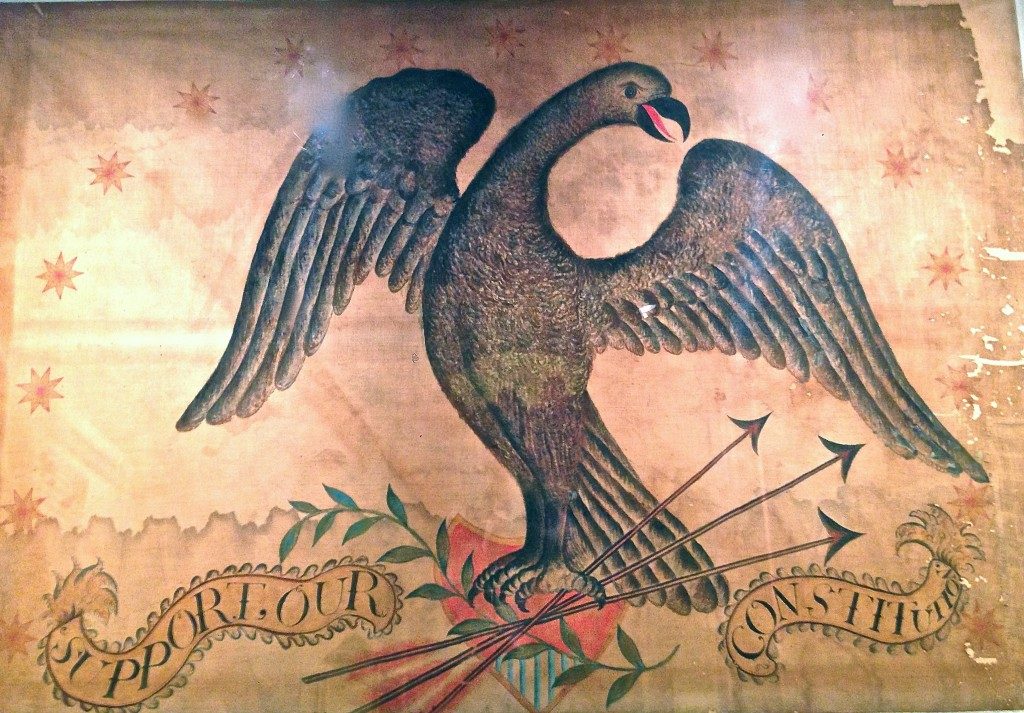
The Grand Lodge of Philadelphia, Joseph Write Begun in 1792/93
Before Dying of Yellow Fever
************* *************
Just like Robert Scot’s Allusion based Transformational Scrolling Art for America’s federal insignia, the Aegyptia Anguis symbol was introduced under the Allusion of the American Rattlesnake. This is not the same as the transformational Phrygian Cap & Liberty pole, because they hold no allusions to carry forward a hidden purposeful meaning. The Rattlesnake symbol is a timeless allusion used in-order for the Enlightened Gentry American Revolutionaries to usher in a New Era of Enlightenment basing their Ideals under a new concept of The Grand Architect’s Design. George Washington, The Founding Fathers, and a Secret Council of Enlightened Revolutionaries were all able to harness their own personal enlightenment in an architectural plan to usher in a new more civilized society that was free of the constraints of mankind’s kingly or authoritative parameters.
As a chessboard has pieces, they purposefully implemented a framework to serve as a template in which ancient cultures and religious teaching lessons would facilitate their New Age agenda in a positive manor through both vehicles of allusions, and straight forward rebellion. Analogy, this should be scene as enlightened men of their era knowing how to design a new kind of chessboard, craft the necessary pieces, strategically place the proper pieces with specific intent, and then provide specific tools for each piece to be successful in their individual missions. As with some of the founders, enlightened council members, and George Washington, the newly constructed network consisted of membership of different nationalities and religions. This multi-culture perspective allowed the successful implementation and integration of the colonial subjects at both social and economic citizenry classes. As with playing chess, there are many moves needed to achieve objectives, it would be short sighted to believe their conquest over the British Empire was the end game when in actuality it was the beginning. For the games strategic moves has never stopped being played to this day. With each modern day victory over our foes, our country benefits from the newly developed framework. This template allows for modern day strategic positioning which allows for the integration of newer enlightened idealisms which moves our society forward through it’s current tribulations. Hence, your beginning of understanding how the Rattlesnake Button’s function is a Timeless Chess Piece which could be re-used in future tempestuous times.
*************

************* ************* *************
The Rattlesnake Button W/ Two Sides
One Side as A Masonic Ancient History Tribute & One Side Geared for Patriot Propaganda
I like Dale’s description of this Post-Revolution Rattlesnake button. He calls it, “The Ninja Rattlesnake!” So appropriate, clear, and precise in his understanding and translation of true meaning. While I was viewing the design’s allusion in a military parameter of Operational Security. Meaning, the Allusion of the Rattlesnake design offered the Council of Enlightened Revolutionaries a design which would not inadvertently divulge to the British Army any part of their organizational structure; or any other information that they would be able to exploit or understand how the Revolutionaries (Chess Board) were strategically setting-up and implementing their strategy. Dale saw the bigger strategic maneuvering of the Rothschild family regardless of which King or country was at war with each other. That didn’t matter. What did matter was the way they can control America’s Resources regardless of who was in political power. As their patriarch once stated to his family, “Let them put a Crown on whomever brow they desired, as long as I control the money of the country.” This is truly the end-game of the Enlightened Revolutionaries. Another Timeless component of All Rattlesnake buttons Allusion.
Their is no simple answer or definition I could offer, accept that Rattlesnake buttons should be viewed as an enigma of sorts. A multi-facet button that was created with specific purpose and meaning with intent on so many levels. What we will try to do is provide our insight on the 2 of the 3 levels for the King Killers operate and use avenues I am not familiar with (Maybe Dale).


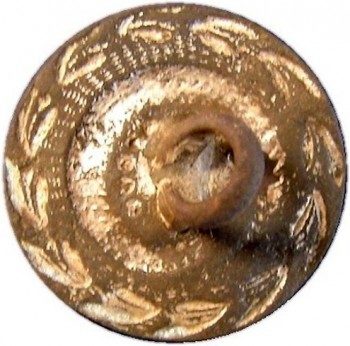

Figure 1 Figure 2 Figure 3 Figure 4
A good starting point for breaking down the dynamics of the Rattlesnake buttons is from the hidden Masonic messaging on the reverse design. This is the part of the button that was specifically geared as a Hidden Tribute for the patriots working in the positive Masonic Lodge network who worked as soldiers in the strategy of the Council of Enlightened Revolutionaries. Their individual contributions of foot soldiers toward the Patriot’s goal of Independence from British governance was immeasurable. By the use of the back of the Rattlesnake button they were able to maintain Operational Security on the level of the Masonic foot soldier.
So, if your a brother in the Scottish-Rite Lodge in Philadelphia the 1792/5 Rattlesnake button’s reverse would have a Masonic Lodge Religious Ritual Significance. The design in this Rattlesnake button variant is the same Artisan rendition of the Scottish Royal Culture Religious tribute flag that graces the Grand Lodge of Philadelphia. It would be a mistake for a researcher to believe a Scottish Artisan was responsible for the Rattlesnake button’s reverse design because Masonic Lodges were open to artisans of all nationalities. This specific Scottish-Rite Flag was started by Joseph Write in 1792, and then finished by another lodge member of a different nationality.

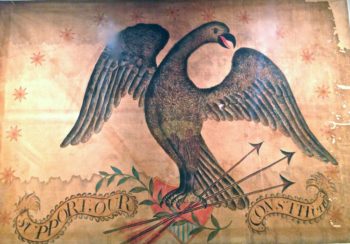

Researchers should note the reflection of 17 Inanna / Ishtar 8 pointed Stars for Accurate Completion dating.
So, if your an artisan of this lodge the button’s reverse is a clear representation of an image, that carries the celebrated Scottish Royal cultural heritage and historical contexts with associated religious meanings. By lodge member’s wearing a button over or close to their heart; it is understood by the wearer that it is a hidden tribute to the Scottish-Rite Royal Culture and Judaeo-Christian foundations of Masonic brotherhood. Naturally, the reverse would be hidden from the common citizenry as all their ritual lodge practices are.
Obviously, the reverse insignia holds deeper Scottish historical religious meanings, but no need to dive deeper into cultural meanings other then the fact that it was designed purposefully on the Rattlesnake button’s reverse for Scottish history. As the eye of the Rattlesnake’s button on the reverse is a reflection of ancient religious significances to Inanna. The bird’s dove like appearance is symbolic in it’s representation of St. Columbia of Iona, who converted the Scottish Pictish people. Hence, the Scottish Royal Culture is accurately depicted and reflected in historical deep seated meaning to Scottish-Rite Brethren.
************* ************* *************
The Multi Allusion Significance of The Rattlesnake Button’s Tail
The Design of the First Rattlesnake button by Sir Robert Strange was the Framework Sanctioned by the Council of Enlightened Revolutionaries, & then used by Robert Scot and his Artisans in other Rattlesnake button Variants.
************* *************
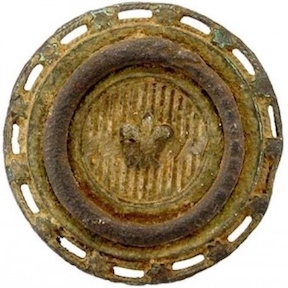



French Masonic Officer Scottish-American Patriot Scottish-American Patriot French Masonic Officer
1778-1784 1776-1815 1776-1815 1778-1784
Scottish-American Patriot Scottish-American Patriot Scottish-American Patriot Scottish-American Patriot
1792/5-1815 1792/5-1815 1792/5-1815 1792/5-1815
************* *************
The Scottish-Rite Masonic Lodges in the American 13 Colonies welcomes people of All Faiths and Religions. Even though the button’s design is a reflection into Scottish Royal Culture and Judaeo-Christian morality lessons; The Masonic Freemasons of All nationalities would be able to wear and understand the hidden meanings by way of their steps in the three degrees to become a Master Mason, and then learning through the 7 step levels of higher Masonic education.
*************

In Dale Hawley’s Diagram above, he skillfully illustrates how the Rattlesnake Button’s design was able to easily transform and take on a new dimension as the country moved forward into a Post-Revolution era. As new states entered into the union, the Artisans accurately depicted their numbers by adding extra rattles to the tail. The two questions that must be addressed is “How come the Rattlesnake button made in 1775-1784 depicts the Rattlesnake devouring it’s own tail?” Second, “Why in the Post Revolution Rattlesnake variant no longer devouring it’s own tail, but places the two extra Rattles hidden inside an open mouth, for what message?”
The first question comes from the bible, and gives us a deep pious religious meaning for the new societal construct of the Grand Architects Design. The lesson depicted is taken from (Dan) Sampson’s final act of self sacrifice. Sampson’s death was caused by himself deliberately collapsing the two supporting pillars of a building he was in, in-order to destroy all the evil denizens at the same moment of his own death. In Talmudic tradition Sampson’s death was linked to the Snake that bites the horse’s heal in order to kill the rider, but is crushed by the horse collapsing upon it. Genesis 49:17: “Dan shall be a serpent by the way, an adder in the path, that bites the horses heels, so that the rider shall fall backward.”
We know the Lawrence Washington Wax Seal made by Robert Scot and his Philadelphia artisans show the snakes eating themselves within the monogram’s grooving. This depiction can make reference of mankind’s thwarted nature of greed and power over the common good of their neighbor. This self-eating snake depiction is a reflection of how the European Society construct of high-society and Royal families nature can easily get corrupted because their false value their social, economic, and political positions of power at the expense their fellow man (subjects). The 1789 George Washington Inaugural button GWI 22-B depicts the snakes eating other snakes also. So, one is the Rattlesnakes which reflect our society as a whole, and the other with plain snakes represent the smaller people of power who are the genetic make-up of the society as a whole.
The second question is a little more difficult to interpret. It recognizes the progress of the Grand Architects design in the United States as progressing forward in unity and building a enlightened (utopian) kind of society. The artisans depiction of Vermont joining the union in 1791, and Kentucky joining in 1792, is reflected in the two extra rattles within the snakes mouth. There are two meanings for this. First, the small (baby teeth) rattles in the Rattlesnakes mouth represent the infancy stages of Vermont & Kentucky that are in the process of maturing into statehood. Meaning, they are not viewed as full rattles for their place in the constitutional body of the United States. Also, by placing the two rattles inside the snakes open mouth it serves as a warning against mans true nature, and what lengths these statesman would be willing to take at the expense his fellow man for gains in his own (States-hood) prosperity. Beware, the Rattlesnake’s mouth can snap shut quickly because of mans untamed nature in not being evolved enough to control his self-egotistical instincts of lustful power over his fellow man; regardless of the recipient’s cost or welfare.This snake would act as a counter-agent of the Enlightened Visionaries goal of a New Enlightened Era with Ideals based in Unity, Prosperity, and Independence. Therefore, the everlasting transforming Rattlesnake buttons of 1792, along with other post rev-war Robert Scot memorabilia like, Federal insignia, State Militia Flags, Wax Seals, ect.. once more reflect the foundational religious framework that was used and needed as base elements of the enlightened visionaries new societal construct. By using biblical Judaeo-Christians moral lessons, numeric values in their new societal framework it provided America a pathway into the New Age of enlightened ideals. By propagating man upward through the Grand Architects Design we unite as a whole species without the cost to others. This is the true species evolution that cannot be achieved through the old European societal construct.
As Dale recently conveyed to me in analogy, the Egyptians, Greeks, or Romans as they then, or our Blessed United States now, or in the future will fail to notice, heed, or respect what is before us in “Plain sight.” We will learn the hard way that nothing is truly forever, and that every great society will fall hard on its own sword. History tells us this, and so does God in his natural order of the Universe. We are born, then we mature, and then we die as all things created. Our sun will burn bright in the planets heavens and then fade as our universe will do someday. Everything comes and goes, and Einstein said it best: the only thing constant in the universe is change.
Below, I will illustrate how the same button artisans under the direction of Robert Scot’s purposefully painted this Transformational Timeless Rattlesnake onto State Militia Flags with hidden embossed symbols geared toward Scottish Military Officers who previously served under George Washington in the American Revolution. All the Rattlesnake buttons together in concert with the State Militia flags gives us concrete evidence (Window inside the Artisan’s Workshop) of how the Enlightened Revolutionary’s instructed and carefully anticipated their Chessboard moves under the Grand Architect’s plan.
************* ************* *************
Artillery Company of Newport, Rhode Island
1791 to 1793
*
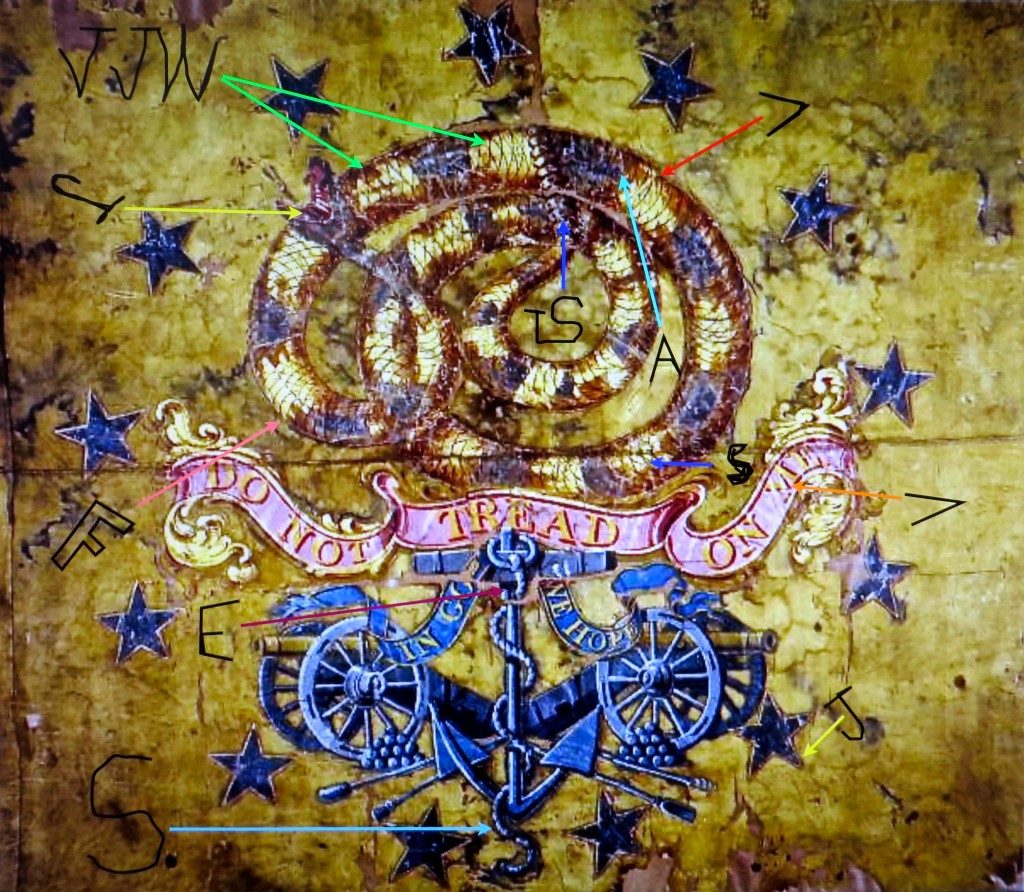
************* *************
The Artisans: Robert Scot, Joseph Wright, Francis Shallus, John Vallance, and Samuel Allardice. J. Thackera, and possibly other Artisans.
The state militia flags of Post Revolution gives us irrefutable evidence that the same Artisans working with Robert Scot designed and engraved the Rev. War Rattlesnake buttons.
Rattlesnake Flag of Colonel John Proctor’s General Arthur Saint Clair’s
1st Battalion West Moreland County, Pennsylvania 2nd Regt. 2nd Brigade, 5th Division
Post Revolutionary War Flag 1791-1793. Post Revolutionary War Flag 1791-1793
*************

************* ************* *************
Robert Scot and his Philadelphia Artisans purposefully infused the later date Rattlesnake Buttons with a substructure of religious meaning using the Star of David. This subcutaneous multi-meaning Allusion acts as a foundational cornerstone that is present in the snake and eggs design to make 4 Stars. The Patriot’s eye would normal capture the obvious Star Snake pattern with the 13 Eggs as a representation of the 13 States. The forward message to Patriots would be of there struggle of liberty and independence. When we start to peel away the each layer of Allusion we see multiple meanings. The next subcutaneous layer would be the incorporation of 3 Star patterns to represent the American Flag, Red, White, and Blue. As we peel away to the next Allusion we see the 4th Star come into play as the representational meaning of the 4 Seals of Solomon. Hence, the Rattlesnake button is properly infused with the integration of the New Republic’s flag and Hebrew foundational roots of all mankind. This 6 point symbol is also used in a reflective nature to represent the Scottish Royal Cultures use of the Honey Comb to base their divine authority. This aspect was the foundation for certain George Washington inaugural buttons.
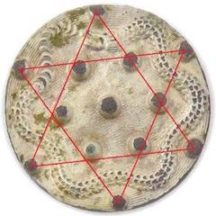
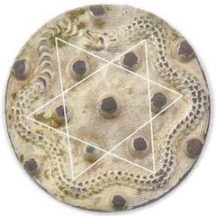
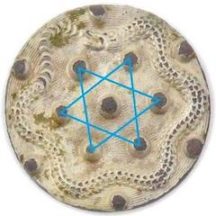
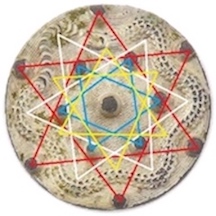
The Enlightened Visionaries did receive in-direct support for their Rebel Cause through the Rothschild family probably by the Sinclair bank in Naples Italy. The Rothschild didn’t care about who was in war with who. They came at the angle there was profit on all side regardless, so they simultaneously banked England and Germany at the same time. Understanding their and appreciating their support, the Scottish Artisans added an extra layer of Allusion to the Rattlesnake buttons to add a new dynamic that would show appreciation, and more importantly keep the door open for financial support in America’s post-revolution era. This caliber (sort-of-welcoming mat) of recognized European high society appreciation was a two edge sword for the Enlightened Revolutionaries. They wanted and took the appropriate steps in their Grand Architect’s Design to be free of the European wealth controlled societal construct. On the other side of the coin, they understood America’s was a poor country, but abundant in needed global natural resources. They foresaw a channel of funding would be needed by future American entrepreneurs to set up the appropriate foundations for economic prosperity.
This was a balancing act for George Washington, Alexander Hamilton, and the Council of Enlightened Visionaries. They would have to enact safeguards into the framework to remain true to the Grand Architect’s Design, but also allow financial support through carefully channeled avenues while still maintaining the public the Allusion of America’s Financial Sovereignty. A behind the scenes negotiation must have taken place between Hamilton and the Red Shield (Illuminati) with an understanding of limits on how America’s natural resources would remain in control of Americans. Profiteering interest would be the fruits of the Rothschild family in areas of economic development through the Bank of America’s loans later. This deal might have been negotiated because of the financial constraints of the Bank of New York. This was established earlier after the Revolution pretty much ended on February 23rd of 1784, when Alexander Hamilton established the Constitution for the Bank of New York located in the City of New york.
In 1791, under mounting pressure of the country’s war time debt, Alexander Hamilton used that opportunity against George Washington’s wishes and took the initiative to persuaded or leverage Congress to grant a twenty year charter and establish the 1st bank of the United States. George Washington did not want the Rothschilds who were bankers of the Revolution now profiting off his New Republic. He knew the Rothschilds coerced England out of their banking system, while at the same time stealing away their colonies in America. George Washington and the Enlightened Visionaries new the Rothschilds were profiting on the blood of both the patriots serving in the Continental Army and the British soldiers. Dale mentions that in Great Architect of the Universe’s design, God sometimes uses evil to beget good in his creations. When Alexander Hamilton was green lighted from Congress to establish the Bank of America, it would be reasonably argued by American historians it was in name only. America in the post revolutionary times was a broke country that desperately needed economic aid for entrepreneurship and stabilizing the federal government. So, in Truth, it was actuality secured by the Rothschild family’s wealth and name in multi-global banking.
In the diagram below, we will use the same design of 4 Stars once more to offer another view of the layers of multi-allusion. This time the Rattlesnake button speak to a different receiver (Rothschild-Redshield-illuminati). This time the Dark Prince is represented by black, and is reflective of the Rothschild’s Coat of Arms in the 18th century which uses all four colors red, white, blue, and black. This would represent Rothschild’s 5 sons, one being the dark prince who would work against the Enlightened Visionaries Grand Architect’s Design. The Red Star would be the representation of the Rothschild family through the Red Shield of the Illuminati. Also,the Black Star could be seen as the Black Prince’s control over America. The 5th Star would be located on the reverse of the button.
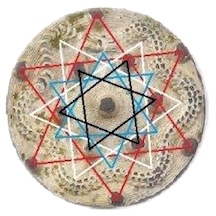



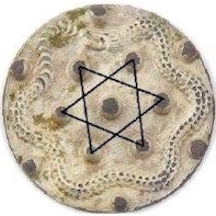
Robert Scot was most likely was an “Unknown Superior” in a contemporary form of Scottish-Rite Masonry called, “Strict Observance.” This new kind of Masonry was devoted to reforming the ancient practices relating to Templar traditions and occult practices in lodges. The founder of Strict Observance was a German named Baron Karl Gotthelf von Hund. He was said to be initiated in 1743, after he converted to Catholicism by Prince Edward Stuart of Scotland (Knight of the Red Feather) and other Jacobites of high society in Paris, France. This might be the high society “unseen tie” between the resurrected Knights Templar, Scottish-Rite, Strict Observance, and illuminati which blossomed in the late 18th century. The designs on all American Revolutionary War propaganda and later federal insignia all have Scottish Royal Culture or high society tributes.
******* ******* ******* ******* *******
The Triangle Scales on the Rattlesnake’s body also holds a multi-Allusion significance. As shown in the diagram below provided by Dale Hawley, Robert Scot and his Artisans were placing their hidden Signature engraver maker marks for artist identification; as with all their purposeful era substructure art (objects) which establishes a foundation for America’s Heraldry.
the triangle design body and alternating design of the tail would hold a base key of three unifying the different worldly cultures. Also, allow the Signature of the engraver for Joseph Wright.
obverse notes:
Craft in final draft :Their patriarch once stated to his family let them put a crown on whomever’ s brow they desire as long as I own and control the money of the country. 15 rattles indicates the time period of1795 to 1812 what’s important is that family Red Shield had agents here in America starting the first “Bank of America” it is thought by some it never was our bank only in name a great allusion to dupe the public like the Royals of England and was most likely a new branch for controlling a young nations banking system to acquire additional wealth. They owned or are deeply involved in all three nations banking system let them wage war on each other that will be financed readily and the empty seat is nourish and the financers with coin. It is still going on to this day. I’ll send a new diagram with the three star symbol.
I’m going to make the largest Solomon seal star Red as it is now on the rattlesnake button followed by the second largest star colored white as it is now and make the third star Blue that is currently yellow in color and the smallest 4th star at the center of the button BLACK for the Black Prince. If there were confidential 18th century schemes this acknowledges they are seen to all others it will mean nothing or something different but at the end of the day financing war is profitable as is banking a young countries endeavors.
I started with red, white and blue on the rattlesnake button and will change the yellow color Solomon Seal Star to black for the dark prince the Rothschild’s will understand.
1795 to 1812 what’s important is that family Red Shield had agents here in America starting the first “Bank of America” it is thought by some it never was our bank only in name a great allusion to dupe the public like the Royals of England and was most likely a new branch for controlling a young nations banking system to acquire additional wealth. They owned or are deeply involved in all three nations banking system let them wage war on each other that will be financed readily and the empty seat is nourish and the financers with coin. It is still going on to this day. I’ll send a new diagram with the three star symbol.
Dr. Benjamin Franklin at 25 & 52
Unfortunately, not everyone is open and able to receive enlightenment. This is not a gift that God gives you, it’s something you come around to and take a new understanding on how things work. Not all of our 1775 Revolutionary Patriots were enlightened. Fortunately, for the New Republic their was enough of these men in the right positions to further facilitate the direction the colonies needed to become a Sovereign Nation on the World Stage. These men are the secret Council of Scottish Royal Culture based Revolutionaries. They were able to bring a dynamic through George Washington to enable America as a self governing country to stand on it’s own two feet and usher in a New Way of life based on the precepts and ideals of the Masonic Constitution. One that was free to grow and expand at an exponential rate if unhampered by mans need to control from a king or parliamentary style court. A formula was provided in the disguise or Allusion of the Grand Architect.
So, where do we begin with this adopted symbol, and what is its true meaning. As with all my research you must choose a definitive point which directly points to the use, intent and context of the symbol being used. We cannot take it back to the Egyptian Snake even though it is woven into the fabric of the meaning. Using 1775 as the breaking point for our Patriots, one could only conclude these sophisticated Council of Revolutionaries would have had the foresight years in advanced. These men were the Best in propaganda advertising and their messaging through the Rattlesnake button has a timeless elements which could be carried through centuries to come. Researchers would be Wrong to conclude it was confined to the American Revolution during 1776 to 1784. When in all actuality, it was carried once more during the British invasion of 1812-1815 War once more with new Rattlesnake motif buttons which could have originated with the foresight in 1792. So, understanding all the complexities of the European chess pieces at play, and all the overlapping Allusions with multicultural meaning for European aristocrats playing on a worldly chessboard I would venture after the Battle of Culloden in 1746 and carried into the American theatre by Robert Strange exiled in France through his student’s Robert Scot in America. The propaganda use of the Rattlesnake on a button itself probably died out with the modernization of propaganda through other more facilitating vehicles.
Historians and Rattlesnake button collectors should understand there is a parellel misconception by American citizenry that Dr. Benjamin Franklin’s eight piece segmented snake first published in his Pennsylvania Gazette on May 9, 1754 is the same Rattlesnake the Scottish Revolutionaries used in their historical representation of the Rattlesnake hissing, “Don’t Tread on Me.” As noted earlier, this is another form of Operational Security that was able to be harnessed in the shadows (Allusion) of Dr. Franklin’s messaging of unification of the colonies. Dale, noted to me that some newspaper prints after Dr. Franklin’s 1st introduction of the snake did use the Rattlesnake to portray the divided colonies, but it was after the outbreak of the Revolutionary War fought behind the scenes from 1774, forward. Dr. Benjamin Franklin’s segmented snake used a form of complex multi-layer messaging of colonial 2nd class citizenry status as a representation of the divided states, and he was giving clear advice as a Patriot loving of his country that unification would be needed to challenge the control that Great Britain has in political and economic domains. At this point, I am not giving you the True meaning of the enlighten men (Council of Scottish Revolutionaries) use of the Rattlesnake. Your lens still needs to widen to fully appreciate and understand the historical context and meaning which will be a timeless Rally-Cry in all it’s facets.
*************
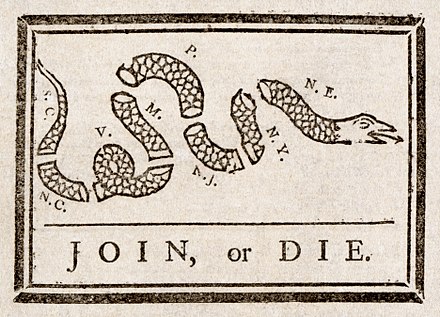
Dr. Benjamin Franklin Political Cartoon Join. or Die.
Revolutionaries Meaning of the Rattlesnake is very complex because it uses historical connotations with deep seated meanings stemming from everything in Creationism to the Kabbalah and it’s inner workings through the nature of the universe. Using various lessons learned throughout history from cultures all over the world, it allowed the enlightenment architecture of the enlightened Revolutionaries to harness this world history and offer a perceived Natural World Order Way provided by the Grand Archetict in a positive nature to build a New Republic. Yup, the New Era of Scottish Enlightenment which will be reflective of many religious lessons along with Masonic Constitutional values for man. The reflection of this New Era would be guided by the enlightenment of God’s way of simplicity, but through a complex Multi-Allusion for man’s benefit because of his humanly nature. Yup, fucking home run! lol
So, where does this leave us in our quest for Truth in the understanding of the Rattlesnake button’s true meaning. As, just mentioned there is not one answer, but two. The simple answer is for the common man to understand. So, I give it freely, and as simple as I am able too. It is to Control the Natural Resources of America in a Worldly dominated Chessboard that was set-up by European Kings who claim ownership of these coveted natural resources for economic control and political power. These European kings fortunes date back centuries because their fortune of hereditary bloodline’s actions made it a false natural order by giving the population it was granted by or lineage to the ancient Gods. Keeping education, knowledge, and scientific discoveries under their direct control, and by only providing it to families of birthright or bloodlines it enabled King’s to maintain a lofty status over their subjects for centuries.

The Rothchilds support the Patriots in the USA at the same time as they were provide funding for England and Germany.
“Rothchild-Red Shield Illuminati financing the war against the “King of England” To the trained eye, we are saying this war is fought behind the veil of normal diplomacy between 2 kings playing chess. The world looks at the chessboard itself, instead of behind the scenes. To control America’s resources from the earth’s mining and trees. As all perceived Gods use religion for kings they embed their symbols with high morality religious means.
Draft information below
Rattlesnake in Shape of A Hebrew 6 Point Star
<~ ~ ~ ~ RATTLESNAKE BUTTONS ~ ~ ~ ~>
Rattlesnake buttons were social-political buttons that were made for American Revolutionaries. Some patterns date prior to the revolution, but most date during or after the Revolution. They were worn as a propaganda tool by American colonists who sought to right their economic prosperity against the British’s government’s oppressive rules and economic policies. The original steel dies were engraved by Robert Scot and his Philadelphia band of engravers. It is my belief that the dies were then sent across the Atlantic Ocean to France for manufacturing. By identifying engraver maker marks, and symbols on the buttons we were able to identify Royal Scottish Culture symbols. These ancient Heraldic Religious symbols were purposefully placed within the button’s design using an artists technique of allusion. Unless the on-looker knew and understood the symbol’s allusion they would be oblivious to the true meaning behind the the country’s newly adopted insignia. – Masked in Plain sight. This allusion technique was also used with later George Washington inaugural buttons, State Militia Flags, and newly Federal adopted insignia. All of which grants the underlying foundation of ancient authority and heraldry granted from God.
From my research, I believe the Rattlesnake button found at the home-site of Brigadier General Augustas Washington was the first (Original pattern) Rattlesnake design and button made in a series of Anti-British propaganda buttons. Since, Sir Robert Strange’s maker mark is present on this button, I believe he was the one who originated the pattern idea and design for the Scottish-Rite American Revolutionaries. The pattern itself uses past religious and cultural lessons from different times throughout history; but I believe Strange used this design specifically for it’s moral conjecture about British empire policies upon it’s citizens. Conjecture and speculation can say this designs also reflects his own disenfranchisement with the British which caused his own exile in France.
We also see Robert Scots and his apprentice Francis Shallus maker’s mark on the button. This led me to reasonably conclude that Sir Robert Strange sent over an unfinished die from France to America. Strange most likely came-up with the idea and started the die while he was in exile in France. He then sent it over to his old apprentice Robert Scot in America where it was finished with his Philadelphia Artisans. Of course there is no clear evidence that the steel die originated in France during Strange’s exile, but I do believe with almost certainty it was returned to France for manufacturing.
Since there is a very limited number of Rattlesnake buttons i do not believe it was made for the general population. These were high quality propaganda buttons which were most likely worn by colonial Revolutionaries associated with Scottish-Rite Freemasonry. One can even conjecture certain patterns were associated with Masonic Lodge members of specific geographical areas. There were York-Rite Masonic Loyalists who were pro-British, and wore Loyalist buttons. To British troops and Loyalists they see these as anti-British propaganda buttons, and the wearer seen as a traitor to the Empire. In the beginning, Rattlesnake buttons were most likely worn in secret by Revolutionaries and Jacobites who normally met at their neighborhood Scottish-Rite Lodges. Some historians call them Jacobite strong holds of democracy; like in Fredericksburg, Virginia where George Washington and 33 Revolutionary War Generals hail from, or even South Carolina. These two states have produced the most metal detector finds.
The Rattlesnake pattern demonstrates a strength in the conviction and the resolve of the Revolutionaries that wore them. In Revolutionary War years this button would be considered an act of treason by the British and most likely demand the strong penalty of death to the wearer. This should be looked at as propaganda tool by the Revolutionaries to make a social statement of their strong convictions of equality. There are other state militia Revolutionary War parallels to take note of. Like, the 3rd South Carolina Regt. known as, “The Liberty Caps.” Officers in this unit wore gorgets that had an engraving of a coiled Rattlesnake ready to strike. One can even conclude that all of these officers were most likely Freemasons. Hereby, creating a kind of sudo-link to finding some Rattlesnake buttons at South Carolina Revolutionary War sites. Obviously, there is no concrete evidence either way. There is no officer portraits or written documentation detailing a connection or use of Rattlesnake buttons. What I know is that if the Rattlesnake button was Masonic in origin an officer would only own one to wear. This is not a button you would trim your coat with. (Just as I would only wear and have one pin for my lodge today). Second, it is a known fact that most Revolutionary War soldiers wore Plain Clothes buttons and Livery Buttons along with their Specialty Unit number buttons as replacements or just in conjunction if desired. This fact by enlisted-men points me towards certain officers wearing this Rattlesnake button as a propaganda piece and serve his station in society.
The Jacobites who wore Rattlesnake buttons were the generational children of the Scottish Royal bloodlines who became American Revolutionaries. Their was an undercurrent theme besides the Patriot Cause that should be noted. These Revolutionaries families has been in a continued struggle for their own religious and economic freedom. Many of these families parents or grandparents were socially and economically effected from the dethronement of King James in 1688. The who Jacobite revolutionary movement was a symbolic rally-cry against the British Empire’s stifling economic policies. (This is slightly different then the 1745, Culloden Battle by Scottish Royal family members who were first barred from higher political and economic positions that were once theirs within the British Empire).
There is two types of Rattlesnake button patterns with a few sub-variation patterns. The first variation has the Rattlesnake devouring it’s own tail. This represents how the British government’s social and economic policies were suppressing the colonists. The point of the Rattlesnake devouring it’s own tail is to state a moral lesson on how society without equality can lead to it’s own self-destruction. This pattern has a 13 star center which represents the 13 known colonies in despair. The second variation has the Rattlesnake hissing with dissatisfaction while wrapped around a Liberty Pole with a Phrygian Cap placed on top. This depiction could have a number of cultural root ties that come from ancient civilizations. But for the button’s purpose it was taken from the Bonnie Prince Charlie who used in 1745, as a propaganda statement against the the oppression of Scottish Royal family members being barred by British Royals in economic positions of power. This stemmed from the dethronement of King James in the Glorious Revolution in 1688. This variation also depicts the 13 colonies united together as one by having 13 eggs arced above the cap.
Earlier uses of the Phrygian Cap can date back to the ancient Phrygians, Greeks, and Romans. Around 44 BC in the Roman Senate a group of outraged Senators used a Phrygian Cap on top of a pole as a propaganda statement to symbolize the Roman people’s needed freedom from the tyrannical rule of Julius Caesar. This might be the first occurrence where a pole was used in-conjuntion with the Phrygian Cap. The pole was used to represent the oppressed taking a strong stand against Caesar, and Phrygian Cap on top represented the liberty and freedom from his rule. I did have some circumstantial research that might have earlier roots then the Phrygians that come from the ancient Egyptian Magi Priests who were super scholars / builders who wanted educational secrets in mathematics kept by the Pharos.
Understanding How Buttons Were
Used by 17th & 18 Century Aristocrats
in European Countries
*
************* * **************
In the late 17th & 18th Century, European Royals and their bloodline Aristocratic families belonged to clubs like the Bean club of Birmingham and the Manchester Club of Manchester. These were actually prominent member institutions that exercised considerable political, economic, and artistic influence upon everyday life. By 1745, there were other prominent off shoot clubs that formed because of the oppression of Scottish Royal family bloodlines who were no longer accepted as part of the English Royal Family establishment of control. This would be like the Jacobite Club and the Gentleman’s Concert Club. Both clubs were associated with both Scottish Royal bloodline members and English Aristocratic supporters like John Byron the English Poet and Scholar. Even the Scottish Prince Bonnie Charlie himself was known to often attended musical meetings.
In this era, political and social support was based by the individuals who were members in these exclusive prominent clubs. Even religious backed power struggles began basing themselves within their own social clubs that attached Royal bloodline family names to it’s membership. A good example would be in 1790, with the formation of the Church and King’s Club. Both of these religious affiliated clubs had their own independence buttons trimmed on their jackets which was used as a propaganda social statement by the elite members for the French Revolution. Actually, the Constitutional Club was then an offshoot of the Church and King’s club; but I don’t want to stray to far away from my point about the origins or propaganda buttons, and why later American Masonic lodges used Rattlesnake buttons for this purpose. The point is that the Aristocratic class in Europe used Specialty Buttons that were trimmed on their club jackets as a propaganda statement. A collector should see this as a fashion social-statement amongst it’s members.
These predecessor clubs with their Specialty propaganda statement buttons is what I believe to be the origins of the American Rattlesnake buttons. One can also make a strong argument for all King and Constitution buttons regardless of Scottish or English attribution. Rattlesnake buttons were made for the members of the Masonic Lodge. I believe this grass-roots tradition started southern states with a strong Jacobite influence like Fredericksburg, Virginia or Charleston South Carolina.
Before Lexington and Concord and a few years before the American Revolution, I believe the Masonic Lodge in Fredericksburg, Virginia became became the grass roots of rebellion toward the British Empire’s economic policies. This Masonic lodge was known as the stronghold of the Jacobites; who’s members included prominent exiled Scottish Royal family bloodline individuals who escaped British oppression in Europe. (This lodge was actually chartered by the Grand Lodge of Scotland in 1758). To illustrate a point on the lodges influence on key players in the American Revolution, one only has to look within the roles of the lodge members: General George Washington and James Monroe, and 33 (actually a who’s who) Revolutionary War Continental Army Generals. This Scottish-Rite lodge’s members were most likely the real undercurrent that made the American Revolution possible from a social economic point of view. (Meaning probably not the common Patriot who would meet at the neighborhood tavern to express his discontent with the British’s stifling economic policies). So to the point, one can surmise these prominent men of Scottish Royal bloodlines kept their European club traditions of using Specialty buttons to trim their Masonic Lodge Jackets to make a social propaganda statement. I believe they chose the indiguonous American Rattlesnake as their symbol for their propaganda statement!
Masonic-ally thinking, the idea of the “Foundation Stone” of the New Republic in America was being threatened by the English Empire once again. These buttons would be a normal thing even in todays times to have made for a political or social statement. Two button collector’s points of interest. Most recovered Rattlesnake button (outside of Massachusetts) were dug in southern states like Virginia and South Carolina. Also, if this is a specialty button made for Freemason lodge jackets, it might be one reason why so few Rattlesnake buttons were ever recovered. They might have only been made available to Freemasons or Masonic Lodge members within the network. There also would have been a suppression by the British soldiers for this kind of revolutionary contraband. These anti-british buttons were seen as propaganda statements, and a local manufacturer would have been charged with treason against the Crown. Even though I like the idea that the buttons entered the ports through Charleston South Carolina, I most likely think they would have come from the north into Massachusetts or Rhode Island with heavy French influences in the Navy and Marine buttons. The early Navy buttons shows similar quality white metal construction. Probably not French Military Pewter manufacturer.
Why The Rattlesnake
One cannot say for sure why the Rattlesnake was chosen as the rally-cry symbol by American Masons, but we can speculate that its roots could have first materialized during the French-Indian War in colonial newspapers. We know that in 1754, Benjamin Franklin first introduced the political cartoon in the Gazette, “Join or Die.” This would have been the earliest known pictorial use of the snake in colonial America. It’s depiction was intended to illustrate the need for unification of British citizens in America against the French and Indians. By the time the Revolutionary War stated a decade later, the use was adopted by the American patriots in their social, political, and economical struggle against the British Empire’s governmental rule. There are some other facts that people should consider. There was social-political like minded revolutionaries that liked the fact that the rattlesnake is only inherent to the Americas, and no where else in the world. This would give the American patriots it’s own geographical identity on the world’s stage. Another important point is that the snake symbol can also coincide with past social and moral lessons that are derived from various religions and ancient cultures. The earliest known historical accounts come from the Pictish people and their use of the Pictish Snakes in their symbology. We know later that the ancient hebrews used the snake symbol for the Tribe of Dan. One can even boldly conclude that this is where the moral lesson aspect might stem from. The Tribe of Dan’s snake symbology teaches us about society own demise by self annihilation. The Christian’s even shared the metaphor of the snake in relation to Jesus Christ. One can even provide an argument that a lot of revolutionaries were Freemasons who also held the snake sacred and reflected it in the Mason’s Coat of Arms. So, in conclusion we can see the snake was used by ancient cultures and religions to illustrate the struggles of the people against the oppressive powers in society. The use of the Rattlesnake could be a compilation of all these histories rolled into something that was solely American that revolutionaries could identify with.
Only the American exiled British Jacobites were educated in these ancient civilizations and how these various cultures like the Romans used the Phrygian Cap and Pole to demonstrate their freedom against a suppressive governance of Ceaser. These revolutionary aristocrats took the Rattlesnake to symbolize America, and combined it with the Prince Bonnie’s earlier re-introduction of the Phrygian Cap and Liberty Pole to make a symbolic button for like minded revolutionaries to wear as a statement. We know at this point in time that American artisans could not have produce these kind of buttons. American buttons were mostly impressed pewter or lathe turned copper. These buttons show a higher quality of workmanship from skilled guild craftsman. These Rattlesnake buttons in my opinion were definitely made by guild artisans in foreign countries like France, England, and maybe Spain. I personally believe that most if not all of these Rattlesnake patterns were made in France, but since some of these Jacobites had ties in their native homelands they could have been made in Britain and Spain as well. I know for a fact that all the artisan engravers no matter what country they lived in would have shared the same education in religions and various Royal family lineages in relation to ancient cultures. That should be an important point to note because it can help confirm their theory that the buttons were made in other countries as well. Spain was put forth to me in an email by Don Troiani because of the planchets had a flash-through presence of the pattern on the reverse. This is a faulty supposition to determine the origin in my eyes for various reasons. The English manufacturing this kind of button which supports the Scottish Jacobite revolutionaries against the English Crown doesn’t sound kosher or provide a strong enough case for profit over English Crown Loyalty.
The very first official Military Rattlesnake Pattern button was thought to be adopted by the Continental Navy for the for the use on a full dress uniform of a Post Captain. This particular Rattlesnake button’s pattern was agreed to by a majority of the Naval Captains in a vote in Boston in 1777. They decided the pattern would depict an impression of a Rattlesnake, with the motto “Don’t Tread On Me.” Unfortunately, there have been no examples of this pattern been found to date. So i am going to show a variety of other examples starting in the late 18th century, and end with the military use by the Providence Train of Artillery in the 1840’s.
Robert’s Notes: The key to the Continental Navy issue was the word: ” impression” All known Rattlesnake button patterns I have ever come across are in high relief. Most late 18th century patterns incorporate the patriotic symbolism of the 13 stars. Military issue patterns use the words “Don’t Tread on Me”.~

1778-1784 Rattlesnake Grasping it’s Tail W/ A Fleur-de-Lis
Color: A Brass Yellow With Orange Undertones.
Metal: 2-Piece, Partially Stamped, along with A Raised Design, Brass Button with a Silvered Copper Snake.
Size: 27mm. Lapel or Cape Size.
Variation: Rattlesnake Grasping it’s Tail / 13 Stripes / Steering Wheel / 13 Rectangular Slots / 13 Stars.
Present Condition: A Dug Specimen, A Good Planchet Condition, A Strong High Relief Pattern Remains.
Robert’s Notes: This Rattlesnake button was most likely made in France, but I do not believe it was manufactured in quantity to sell in the American market. The current owner believes his button was made in Spain after the American Revolution during the 1789-1800 period. He claimed that the button supposedly commemorates America’s friendship with Spain, and that is why it was dug in America. When I researched his hypothesis for Spanish origin, I guess he believes the button represents Auroboros Serpent in the “form” of the Rattlesnake? This is the only thing I can find relating to Spain. Even though his conclusion might have a small balance of foundational truth in the specific context of the serpent meaning, I think this context is to far removed, and I just am “Not” in agreement or on-board with any of his theories or conclusions. I feel anything to do with Spain has no relevance to the Rattlesnake that was used by the American patriots as a propaganda symbol to make a social / political statement during the American Revolution. As far as his dating the buttons outside of the American Revolution 1789-1800 it is doubtful for several reasons. I will just site a few. First, the button has 13 Stars to reflect the 13 states. America had 14 Stars in 1791, and 15 in 1792. Artisans usually reflected star accuracy in their engravings or art. Second, the Rattlesnake was specifically adopted by the American colonists because it was indigenous to the US, and no where else in the world. The Rattlesnake became an American propaganda symbol to make a social / economic statement. Next, there are only a few known specimens in this series, and all were dug in America’s southern states. Why no dug specimens in France? Anyway, between these two patterns, I believe a collector can realistically target a period of 6 years. Starting as early as 1778, when the French officially recognized the United States as a sovereign nation, and allied themselves with us in the war against the British. If a button collector looks at the “Swirling Pattern” in my specimen you can see it is a match to other French pattern used by Generals and their Staff Officers as early as 1775. By cross-referencing similar dated French Officer’s patterns, and their entrance into the American war, one can reasonably conclude this series of Rattlesnake buttons range from 1778 to 1784, but I would emphasis the early 1780’s due to it’s unique fabrication.
The bottom line is that America was peopled by 7 countries, and France was one of them. Collectors sometimes forget or underestimate the importance of the role the French played during the American Revolution. As I noted in my research with George Washington Spy buttons, there was three distinctive types: American, Scottish, and French. Just as those distinctive buttons had specific country tribute, I believe this series of Rattlesnake buttons were made for French Officer’s or dignitaries. So, I came-up with three possible theories of who would have worn one of these very expensive Rattlesnake buttons. First, is a French General Staff Officer. Second, is an Official French Diplomat or emissary of the French King. The third is a French businessman who was a revolutionary. He would have had business interests in one of the southern colonies, and he was affected by the stifling economic policies of Great Britain. Which ever theory is correct, one can conclude that these special distinctive buttons were Very Expensive, Very Limited in Issue, and specifically made to be used as Propaganda Statement to show support of the Patriot’s cause against the British.
Arguments for All
If this specialty button was worn by a French Staff Officer, it would have been in an unofficial capacity as propaganda statement to show his personal support for the Patriot’s Cause. He would have worn this button while visiting a friend’s home, a neighborhood Masonic Lodge, or any social or political gathering that was outside of his official capacity as a military officer.
If this button was worn by a French Diplomat or Dignitary, it would be like the specialty buttons that the US Official Diplomates wore with federal related insignias. In this era, official government representatives that were not in the military thought it was authoritative to masquerade themselves in military type uniforms to show their authority. The specialty buttons on these uniforms often reflected that governmental authority. In times of war, these diplomats often visited field staff to provide information, orders, and any official government policies. Having specialized motif buttons can reflected governmental authority and statements.
It is certainly possibly that a French businessman who was an economic revolutionary would have worn one. This individual possibly would have had a social or family tie in France, and business interests in one of the southern colonies. This French revolutionary would have been affected by the stifling economic tax and trade policies of Great Britain. So, he would have worn one as a propaganda statement against the British. He would have obtained one by am American garment maker who received a small supply of these buttons, or would have gotten the button through his contacts in France.
Since, only a few of these specialty buttons are known to exist, and all seem to be dug in America, it leads me to believe they were brought over from France for personal use. Meaning, these distinctive buttons were not available for sale within the states as other French made Rattlesnake buttons were.
The center has a raised Fleurs-de-lis (a styled lily or iris) set upon a base of 13 Stripes. The Three Prong Lily symbol dates back to an earlier period in history before the King of France inherited it. The earliest known recorded use is by the Merovingian King who changed his Crown to use a three prong lily to represent his conversion to Catholicism. This new ornamentation is actually where the name Elizabeth derives from. Centuries later a form of this symbol was adopted by The Royal House of Bourbon. Circling around the inner periphery is a separate applied device of a silvered Rattlesnake Snake devouring it’s own tail. This is a propaganda statement against the British Empire about how their economic policies are in effect consuming their own people. The outside legend has a Steering Wheel design with Thirteen Open Rectangular Slots that have an Outlining Cable Design. This pattern could represents the 13 states ability to guide it’s own economic destiny. In-between the open slots is 13 Raised Six Pointed Stars to represent the 13 states.
Reverse Button Analysis: This is a one-piece button with a loop shank. The shank is reported to be original, straight, and intact, but unconfirmed.
Library Records Has Limited Information on APIP 1:
History: Yes Recorded Sales Price: No
Current Button Owner and Location: ~ Connecticut ~
Excavated in Willtown South Carolina.~
The D.T. Collection.
1778-1784 Rattlesnake Grasping it’s Tail With a Swirling Ray of Rattlesnake Tails From an Egg.
Color: A Chestnut Brown.
Metal: 2-Piece, Partially Stamped, along with A Raised Design, Brass Button with a Silvered Copper Snake.
Size: 29.66mm. Lapel or Cape Size.
Variation: Rattlesnake Grasping it’s Tail / Swirling Ray of Rattlesnake Tails / 13 Six Pointed Stars.
Present Condition: A Dug Specimen, A Strong Planchet Condition, A Strong High Relief Pattern Remains.
Robert’s Notes: This Rattlesnake button was most likely made in France, but I do not believe it was manufactured in quantity to sell in the American market. If a button collector looks at the “Swirling Pattern” they can see it is a match to other French pattern used by Generals and their Staff Officers as early as 1775. By cross-referencing similar dated French Officer’s patterns, and their entrance into the American war, one can reasonably conclude this series of Rattlesnake buttons range from 1778 to 1784, but I would place emphasis on the early 1780’s due to it’s unique fabrication.
The bottom line is that America was peopled by 7 countries, and France was one of them. Collectors sometimes forget or underestimate the importance of the role the French played during the American Revolution. As I noted in my research with George Washington Spy buttons, there was three distinctive types of buttons: American, Scottish, and French. Just as those distinctive buttons had specific country tribute, I believe this series of Rattlesnake buttons were made for French General’s Staff Officer’s or dignitaries. So, I came-up with three possible theories of who would have worn one of these very expensive Rattlesnake buttons. First, is a French General Staff Officer. Second, is an official French Diplomat or an emissary of the French King. The third is a French businessman who was a revolutionary. He would have had business interests in one of the southern colonies, and he was affected by the stifling economic policies of Great Britain. Which ever theory is correct, one can conclude that these special distinctive buttons were Very Expensive, Very Limited in Issue, and specifically made to be used as Propaganda Statement to show support of the Patriot’s cause against the British.
Arguments for All
If this specialty button was worn by a French General Staff Officer, it would have been in an unofficial capacity as propaganda statement to show his personal support for the Patriot’s Cause. He would have worn this button out of uniform while visiting a friend’s home, a neighborhood Masonic Lodge, or any social or political gathering that was outside the jurisdiction of his official capacity as a military officer.
All French Generals or General’s Staff Officer Buttons from the Revolutionary War Era
If this button was worn by a French Diplomat or Dignitary, it would be like the specialty buttons that the US Official Diplomates wore with federal related insignias. In this era, official government representatives that were not in the military thought it was authoritative to masquerade themselves in military type uniforms to show their authority. The specialty buttons on these uniforms often reflected that governmental authority. In times of war, these diplomats often visited field staff to provide information, orders, and any official government policies. Having specialized motif buttons can reflected governmental authority and statements.
It is certainly possibly that a French businessman who was an economic revolutionary would have worn one. This individual possibly would have had a social or family tie in France, and business interests in one of the southern colonies. This French revolutionary would have been affected by the stifling economic tax and trade policies of Great Britain. So, he would have worn one as a propaganda statement against the British. He would have obtained one by am American garment maker who received a small supply of these buttons, or would have gotten the button through his contacts in France.
Since, only a few of these specialty buttons are known to exist, and all seem to be dug in America, it leads me to believe they were brought over from France for personal use. Meaning, these distinctive buttons were not available for sale within the states as other French made Rattlesnake buttons were. Using Louis Fallou’s book, Le Bouton Uniforme Francais” I was able to cross-examine “several” French General and Staff buttons that shows similar Swirling characteristics to the Rattlesnake button I own that is part of this Limited Edition Series with a “Steering Wheel & Star Legend” with a separate “Applied Rattlesnake.” Each button in the series differs by the depicted center pattern. Last note on manufacturing. At this point, Americans didn’t have the manufacturing for this advanced button. We were doing crude mold Pewter impressed buttons. This button is state of the Art with a Gilt or Silver finish. Also the button has a “6” Pointed Star instead of the American 5 Pointed Star. The buttons could have originally been some ind of specialty order, but i highly doubt it. Most likely made by a well known French Artisan in France with an intended user: i.e.. French Officer.
The button’s pattern depicts a Round Dome Egg Center. Reaching out from the center egg is a swirling pattern of 10 Rattlesnake Tails. Circling around the inner design is an Applied Rattlesnake Grasping it’s tail. The Rattlesnake’s tail appears to have 9 or 10 sections to the rattle. The outside legend has a Steering Wheel design with Thirteen Rectangular Open Slots that have an Outlining Cable Design. This pattern could represents the 13 states ability to guide it’s own economic destiny. In-between the open slots is 13 Raised Six Pointed Stars to represent the 13 states.
Reverse Button Analysis: This is a one-piece button with a loop shank. The shank is original, straight, and intact.

Isabela sporting America’s most Sacred Relic. A 1775 Scottish Royal Culture Rattlesnake button used by Patriots who were Scottish-Rite Lodge Members during the American Revolution.


1792/5-1815 Rattlesnake With A Hebrew Six Point Star & Eggs/ Rothschild Red Shield.
Color: Silver With Green Encrustation Patches.
Metal: Flat, 1-Piece, Raised Design, Silvered Copper.
Size: 25mm. Coat Size
Present Condition: A Dug Specimen, A Strong Planchet Condition, A Strong High Relief Pattern Remains.
Robert’s Notes:
Reverse Button Analysis: This is a flat one piece button with a loop shank. The shank is original, but slightly bent.
Library Records Has Limited Information on APIP 2-1:
History: Yes Recorded Sales Price: Yes
Current Button Owner and Location: ~ New Windsor, N.Y. ~
The Robert J. Silverstein Collection.
Found by Archangel Micheal Beck in North East Philadelphia off a Park Pathway high above a Creek in Dec 2016 or Jan 2017. Other North American Indian Relics such as Arrowheads were found in the same vicinity.

1776-84 RATTLESNAKE CIRCLING AROUND THIRTEEN SIX POINTED STARS
Color: A Silvery Gold.
Metal: Flat, 1-Piece, Raised Design, Gilt Brass.
Size: 24mm Coat Size
Present Condition: A Non Excavated Specimen, Exceptional Planchet Condition, An Exceptional High Relief Pattern Remains.
Pattern Variant: The Snakes Head is going Counter Clockwise / Strike Through Reverse-Flash
Robert’s Notes: This is another popular pattern that was sold in the late 18th Century. Some historical research shows this particular pattern was most likely produced in France for the American market. There appears to be two die variations. Both are predicated upon the direction the snake is moving. The button’s pattern depicts an American Rattlesnake devouring itself around the outside edge of the button. To represent the original thirteen states, the snake has 13 circular angled disc shape rattles in it’s tail. The center of the button has 13 Raised Six Pointed Stars that are set on a stippled field. The snake is moving in a Counter Clockwise Direction.
Reverse Button Analysis: This is a flat one-piece button with a loop shank. The shank is original, straight, and intact.
Library Records Has Limited Information on APIP 3:
History: Yes Recorded Sales Price: Yes
Current Button Owner and Location: ~ Virginia ~
Excavated in South Carolina.~
The B. Henderson Collection.


1776-84 RATTLESNAKE CIRCLING AROUND THIRTEEN SIX POINTED STARS SBV.1
Color: An Emerald Green.
Metal: Flat, 1-Piece, Raised Design, Gilt Brass.
Size: 24.57mm Coat Size
Present Condition: An Excavated Specimen, Good Planchet Condition, Good High Relief Pattern Remains.
Pattern Variant: SBV.1 The head is going Clockwise / Plain Reverse
Robert’s Notes: There appears to be two die variations. The difference is in the direction the snake is moving. The button’s pattern depicts an American Rattlesnake devouring itself around the outside edge of the button. There are Thirteen Stars in high relief to represent the original thirteen Colonies, the snake has 13 circular angled disc shape rattles in it’s tail. The snake is moving in a Clock-ward Direction.
Reverse Button Analysis: This is a flat one-piece button with a loop shank. The shank is original, straight, and intact.
Library Records Has Limited Information on SBV1.3:
History: Yes Recorded Sales Price: Yes
Current Button Owner and Location: ~ New York ~
Excavated in Upton, Massachusetts.~
The RJ. Silverstein Collection.
1776-84 RATTLESNAKE CIRCLING AROUND THIRTEEN SIX POINTED STARS “Ultra Rare Cuff”
Color: An Emerald Green.
Metal: Flat, 1-Piece, Raised Design, Gilt Brass?
Size: 15.41mm Ultra Rare Cuff Size
Present Condition: An Excavated Specimen, Good Planchet Condition, Good High Relief Pattern Remains.
Pattern Variant: The Snakes head is going Counter Clockwise / Plain Reverse
Robert’s Notes: This button provides evidence that at least one variant of Rattlesnake buttons was produced in a matching cuff size. The button’s pattern depicts an American Rattlesnake devouring itself around the outside edge of the button. There are Thirteen raised Stars to represent the original thirteen Colonies, the snake has 13 circular angled disc shape rattles in it’s tail. The snake is moving in a Clock-ward Direction.
Reverse Button Analysis: This is a flat one-piece button with a loop shank. The shank is original, and intact, but crushed inwards.
Library Records Has Limited Information on APIP 3.B:
History: Yes Recorded Sales Price: Yes
Current Button Owner and Location: ~ New York ~
Dug by Jayson Agnelli in Massachusetts in October 2015.~
The RJ. Silverstein Collection.


1774-1775 RATTLESNAKE SKULL CIRCLING AROUND 13 SIX POINTED STARS & A CENTER OF STRIPES
MM: Sir Robert Strange, Robert Scot, James Trenchard, Francis Shallus, John Thackera, Samuel Allerdise
Color: A Golden Brown Patina.
Metal: Flat, 1-Piece, Raised Design, Silver Wash Copper.
Size: 23.84mm. Coat Size
Present Condition: An Excavated Specimen, Strong Planchet Condition, A Strong High Relief Pattern Remains.
Robert’s Notes: This Rattlesnake button was made by Sir Robert Strange when he was exiled in France. The die at one time was sent across the Atlantic to America where his student Robert Scot worked on it with his Philadelphia engravers. The button’s pattern depicts a Rattlesnake Skull devouring it’s tail of 13 Rattles around the outside edge perimeter. There is a series of Saint Andrews Crosses carved into the snakes body. Just within is Thirteen Six Pointed Stars circling around 13 Bars or Stripes. This actually has a dimple in the center and should be counted Six Rays plus the center equaling “7” which is representative of God or divinity. There is also a number “5” engraved in the button which is representative to the Scottish White Rose of the Bonnie Prince. The high relief pattern is set on a plain flat field with the snake acting as the raised edge.
Reverse Button Analysis: This is a flat one-piece button with a loop shank. The shank is original, straight, and intact.
Library Records Has Limited Information on APIP 4:
History: Yes Recorded Sales Price Yes
Current Button Owner & Location: ~ New York ~
This was Dug at the home site of Brigadier General Augustus Washington’s home near Charleston, South Carolina.
The RJ Silverstein Collection.
Scottish Royal Heritage Symbols & Maker’s Marks
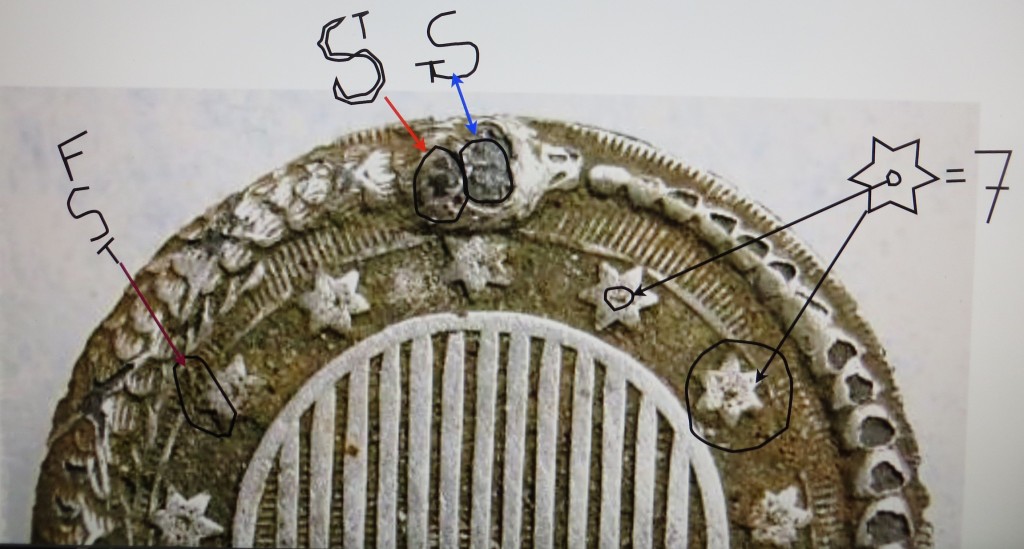
Robert’s Notes: The two large “ST” symbols on the head of the snake can be found on earl Scottish relics, and also on ancient Scottish burial monuments. The first instance this symbol can be seen is on the island of Iona. The island has over 50 Stone Crosses as markers for their dead Scottish Kings. On these monuments one can see the symbol inscribed into the stone. We can also trace this symbol to the design on the Scottish Crown. So, we have evidence that this symbol is found on an array of heraldry objects that have reference ties to the Royal families. There is also evidence that there is an association tie with this symbol to the Piths people; and their use of the Serpent symbolism. There is also some associations with St. Columba bringing Christianity to Scotland. The snake symbol can also include the reference to the Garden of Eden story. All these carry some weight for the snake symbols usage.
The worm on the other hand most likely in references Jesus Christ on the cross claiming, “I am but just a worm!” So, the “S” can be seen as a combination of these various Scottish religious connotations that uses both the Snake and Worm symbols together. The “T” symbol is a representation of Christ’s Cross and the Tau symbol. There is also some merit as it standing for the Royal Scythian symbol for Scotland. This also depicts the snake and the True Tau Cross. Lots of cultural uses over history, each using it for its own meaning.
What can be said is that the “ST” Represents a combination of the ancient history that was well known by Sir Robert Strange, Robert Scot, and all his Philadelphia engravers. I have come to conclude, that this is Sir Robert Strange’s works. He most likely started it while exiled in France. He then turned over the unfinished steel die to his old student Robert Scot. He then worked on it with his artisan members in Philadelphia, Pennsylvania in 1777. From examining the button, I see a classical french design influence. As mentioned earlier, this most likely stems from when Sir Robert Strange’s lived in France. Furthermore, I do not think this would not be a typical style design by Robert Scot. This fact is why I think the design was started in France by Strange. His style is reflected along with his strong understanding of ancient religion and Scottish symbolism. Only Sir Robert Strange would be allowed, skilled and verse in doing all these Scottish Royal Symbols on the button. We see located at the 11:00ʼclock position the “E” which represents the order of St. John. To Scot this represents the intermarriages of his Scot family with the Lord Sinclair and Stuarts. He traces it back to the commander of the Knights of St. John who was part of Mary Queen of Scot Royal court. It was Robert Scot’s maternal grandfather Lord Melville who was known as the Queens real page.
Also, one should be privy to the fact that the letter “E” in ancient Latin often also represent God in some other known ancient art paintings. Below the “E” we see the “VERY RARE” Robert Strange “STR” makers mark. In this instance he fused the “ST” letters with a “V” which then forms a capital “R”. Robert Scot WOULD NEVER do this if he was not trying purposefully to separate his work from his teachers. The 3rd, smaller “ST” maker marks would be Sir Robert Strange’s own initials. The “ST” found on the first illustration is also a clue in dating the button’s creation to 1776/7. Here we see the “T” differs and is wide in size, the right side of the “T” shows a deep cut letter “J”. What this shows me is that Robert Scot and James Trenchard’s initials are jumping off each others marks.
Next we see Francis Shallus maker marks. Francis Shallus was Robert Scot’s young student and contributed to many of his engraving commissions. In the illustration below, we see Shallus common practice of jumping his “FS” marks off of his teacher’s initials. We also see the Scottish Saint Andrew’s “X” symbol for possibly the first or second time placed on American Art . (The Carolina colonial note might be the first introduced, but this steel die might have been started prior (Fig.A.2), we just don’t know). What we can definitely say is that this represents Scotland’s St. Andrew’s Cross. The “X” gives us direct evidence that both Sir Robert Strange and Robert Scot’s started placing Scottish heraldry symbols within American Patriot works of Art early on in the Revolution.. Another unique find I had is the intent of the Six Pointed Star with an intentional Dot placed in the center. I believe the Center Dot carries a Value, and adds to the six rays to represent the real intended value of “7”. To me when I see the value of seven depicted within ancient art, I take it to reference a religious reference to God. There is other values using the “7” throughout ancient history; but when it comes to Robert Scot and his Jacobite Artisans; I believe I am bias toward religious significance.
In the first figure below (A.1), we see the number “5” engraved flawlessly. Here we see Robert Scot pay tribute to the Bonnie Prince Charlie being the Five Petal White Rose of Scotland. So, here again I correlate this number directly to the Scottish fight against the English oppressors. Another important point is that the “White Rose” is known to be a signature of Sir Robert Strange’s art. His student Robert Scot borrowed this idea from his teacher (Strange), and placed it within several other pieces of American engraved art, This includes the proposed design of the Great Seal of the US, and also on an older Robert Strange portrait of a Scottish officer. We see the 5 Petal White Rose on the officer’s hat with the matching engraving on his sword. There is a lot of other symbols and cyphers within this one-of-a-kind Rattlesnake button that was made for General William A. Washington. I promise to research this button further and unveil these hidden symbols.
Figure A.1

Figure A.2: Various Engravers Maker Mark Letters
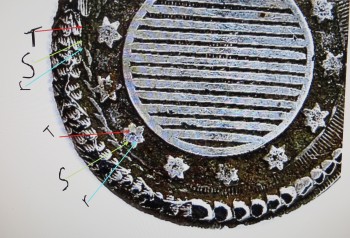
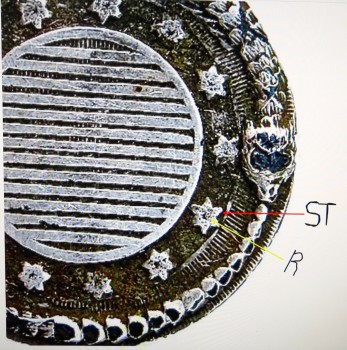
South Carolina Twenty Dollar Currency Note
April 2, 1776

This is the first evidence we see of Robert Scot’s “Do Not Tread On Me Rattlesnake” with the Scottish Saint Andrews Cross. Clearly we can see his rendition of his teacher Sir Robert Strange’s Scrolling Work.
Lastly, we see illustrated above a Revolutionary War period Carolina Twenty Dollar Currency note. Here is the 1st or 2nd instance we see the Rattlesnake depicted along with Robert Scot’s tribute to St. Andrew’s, “X”. We also see the number “5” giving it tribute to the Bonnie Prince. The Carolina Currency note’s helps me date some of Robert Scot’s earliest use for his teachers scrolling art in America. Robert Scot’s intent of using the scrolling art work was most likely an anti-counterfeit technique. This doesn’t give it any tribute to Scotland outside of Strange using it for the Bonnie’s money plates first. So, in conclusion, this Rattlesnake button found on the homesite of William Augusta’s Washington could possibly be the earliest known engraved artifact with the American Rattlesnake–That is Period of the American Revolution.
1792/5-1815 RATTLESNAKE COILED AROUND 13 EGGS WITH A FLORAL BORDER
Color: A Nice White Wash Coppery Brown Mix.
Metal: Flat, 1-Piece, Raised Design, White Wash Copper.
Size: 17mm. Cuff Size
Present Condition: An Excavated Specimen, Strong Planchet Condition, A Strong High Relief Pattern Remains.
Robert’s Notes: I am not 100% sure this is an American Patriot’s Rattlesnake button because of the odd number of representation in the snakes rattle, and outside edge border. Symbolically the number thirteen should be used, not 12 and more then 14. I am including it because there are 13 eggs. This could have very well been made and intended to be used in France. The design also appears to have been stamped from the reverse to show a raised relief on the obverse? The button’s pattern depicts a Semi Circle of 13 Eggs with a Snakes Head inside inside the center. There appears to be an odd number of rattles in it’s tail 14+. Since most of the Rattlesnake buttons are from French manufacturers, I believe the border design could possibly be an artists rendition of a French tulip or iris, but unfortunately, there are only 12, not 13 for correct representation of the states.
Reverse Button Analysis: This is a flat one-piece button with a loop shank. The shank is original and bent to the side. The surface has corrosive and porous properties, but the planchet still appears solid.
Library Records Has Limited Information on APIP 5:
History: Yes Recorded Sales Price: Yes
Current Button Owner and Location:
Dug in Dinwiddie County, Virginia.~
The B. Henderson Collection.

1792/5-1815 COILED SNAKE WITH A THIRTEEN RATTLER TAIL
Color: A Dusty-Brown.
Metal: Flat, 1-Piece, Raised Design, Gilt-Brass?
Size: 25mm. Coat Size
Present Condition: A Dug Specimen, A Good Planchet Remains, A Good/Strong High Relief Pattern Remains. Robert’s Notes: America’s indigenous Coiled Rattlesnake became the Patriots rally cry symbol against “British style” governance and tax policies. This specimen was dug by metal detector enthusiast Rich F. during his dig this Spring in Massachusetts (April of 2017). Several other specimens with this particular design have been found by detectorists in South Carolina. So, one can conclude that the market for this Patriotic Propaganda button reached the northern states as well. Sentiment through neighborhood Masonic Lodges? The grass-roots base of a “Cause” by educated citizens who have manufacturing or trading stakes in the colonies economy. These are the people that make money on people that go to work for a living. These men are the educated to make these propaganda statements and afford these buttons. Not the tavern patriots who just want the jobs provided by these men. These men think spending that much money on a button is wasteful, and something only a person of means would do. My hunch is that it was purchased outside of common markets due to possible seditious nature toward the British. So, maybe through mens garment magazines, or through the neighborhood tailor shops who provided their well known customers with special orders. What ever year you assign this button Pre-During-Post Revolution; the meaning and intent would never change for the patriot who wore it. The button’s simple pattern depicts a Hissing Rattlesnake Coiled Up. The snake’s tail depicts thirteen rattles.
Reverse Button Analysis: This is a flat one-piece button with a loop shank. The shank is unfortunately missing.
Library Records Has Limited Information on APIP 6-A:
History: Yes Recorded Sales Price: Yes
Current Button Owner and Location: Yes
The RJ. Silverstein Collection
1776-84 RATTLESNAKE COILED AROUND A LIBERTY POLE
Color: A Silver with Yellow Undertones.
Metal: Flat, 1-Piece, Raised Design, Silver Wash Copper.
Size: 25mm. Coat Size
Present Condition: A Non Excavated Example, An Exceptional Planchet Condition, A Strong High Relief Pattern Remains.
Robert’s Notes: There appears to be three maybe four die variants for this Patriot button. The only discernable difference is the space between the rattlesnake and Phrygian Cap. In this first die variant the snake almost touches the Phrygian Cap. In the second die variant there is a sizable space. This specimen is fortunate enough to retain some of it’s silver wash. The pattern depicts a Hissing Rattlesnake coiled around the base of a Liberty Pole, that has a Phrygian Cap on top. Arced above on the button’s top edge is 13 eggs to represent the 13 colonies. This button is most likely a French made button for the political cause. The French had also used the old Trojan-Greek Phrygian Cap on a Pole motif during their own revolution in 1789.
Reverse Button Analysis: This is a flat one-piece button with a loop shank. Flash through reverse. The shank is original straight and intact.
Library Records Has Limited Information on APIP 7-A:
History: Yes Recorded Sales Price: Yes
Current Button Owner and Location: ~ X ~
The Dale Collection.
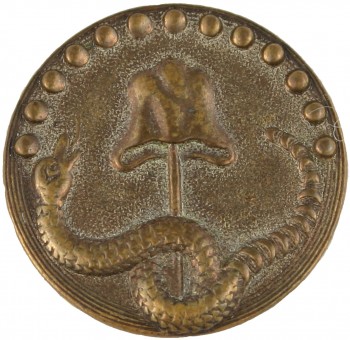
1776-84 RATTLESNAKE COILED AROUND A LIBERTY POLE (SBV.1)
Color: A Silvery-Green with Brown Undertones.
Metal: Flat, 1-Piece, Raised Design, Silver Wash Copper.
Size: 24.5mm. Coat Size
Present Condition: An Excavated Specimen, Good Planchet Condition, A Strong High Relief Pattern Remains.
Robert’s Notes: There appears to be 3 or 4 die variants for this Patriot’s button. The only discernible difference is the space between the rattlesnake’s head and Phrygian Cap, and the evenly lined border. In this second die variant the snake has a sizable space between it’s mouth and the the Phrygian Cap. The pattern depicts a Hissing Rattlesnake coiled around the base of a Liberty Pole, that has a Phrygian Cap on top. Arced above on the button’s top edge is 13 eggs to represent the 13 colonies. This button is most likely a French made button for the political cause. The French had also used the old Trojan-Greek Phrygian Cap on a Pole motif during their own revolution in 1789.
Reverse Button Analysis: This is a flat one-piece button with a loop shank. The shank is original straight and intact.
Library Records Has Limited Information on APIP 7-SBV.1:
History: Yes Recorded Sales Price: Yes
Current Button Owner and Location: ~ New York ~
The RJ Silverstein Collection.
SBV.1 Maybe a Jacobite Masonic Variation used by their Lodge members. Depicted below is the Philadelphia Grand Lodge Flag with the exact head depicted. This variant is the only Snake head like this in all Rattlesnake buttons. Plus the Phrygian Cap motif was taken from Bonnie Prince Charlie use in 1745, and not the Roman Senates earlier use. Steven Motrin a relative of Charlie used it in the City of NY for the first time in America.
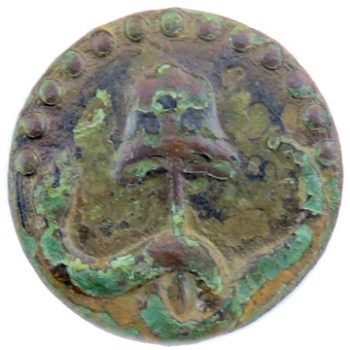

1776-84 RATTLESNAKE COILED AROUND A LIBERTY POLE SBV.1
Color: A Silvery-Green with Brown Undertones.
Metal: Flat, 1-Piece, Raised Design, Copper.
Size: 23.71mm. Coat Size
Present Condition: An Excavated Specimen, Strong Planchet Condition, A Strong High Relief Pattern Remains.
Robert’s Notes: This is another die variant for this Patriot’s button. There are two discernible difference. First is the space between the rattlesnake’s head and Phrygian Cap. The second, is if there is an evenly multi lined border. In this sub variant of the second die variant there is no evenly lined border. This second variant has the snake head a sizable distance between it’s mouth and the the Phrygian Cap, and the evenly lined border. The pattern depicts a Hissing Rattlesnake coiled around the base of a Liberty Pole, that has a Phrygian Cap on top. Arced above on the button’s top edge is 13 eggs to represent the 13 colonies. This button is most likely a French made button for the political cause. The French had also used the old Trojan-Greek Phrygian Cap on a Pole motif during their own revolution in 1789.
Reverse Button Analysis: This is a flat one-piece button with a loop shank. The shank is missing.
Library Records Has Limited Information on APIP 7-bSV.1:
History: Yes Recorded Sales Price: Yes
Current Button Owner and Location: ~ New York ~
The RJ. Silverstein Collection.
Dug by R.G. in Upton, Massachusetts.
1776-84 RATTLESNAKE COILED AROUND A LIBERTY POLE
Color: A Coppery Brown with Silver.
Metal: Flat, 1-Piece, Raised Design, Silver Wash Copper.
Size: 25mm. Coat Size
Present Condition: An Excavated Specimen, Exceptional Planchet Condition, A Strong High Relief Pattern Remains.
Robert’s Notes: This is a rare specimen that is fortunate enough to retain most of it’s silver wash with a strong depiction. The button’s pattern depicts a Hissing Rattlesnake Coiled around the base of a Liberty Pole, that has a Phrygian Cap on top. In this die variant, the snake’s mouth almost touches the Phrygian Cap. There is a flat border instead of multi lined. Arced above on the button’s top edge is 13 eggs to represent the 13 colonies. This button is most likely a French made button for the political cause. The French had also used the old Trojan-Greek Phrygian Cap on a Pole motif during their own revolution in 1789.
Reverse Button Analysis: This is a flat one-piece button with a loop shank. The shank is missing and looks as if it was smoothed down for a coin collection.
Library Records Has Limited Information on APIP 8-A:
History: Yes Recorded Sales Price: Yes
Current Button Owner and Location: ~ Virginia ~
Excavated on Dufuskie Island, South Carolina.~
The B. Henderson Collection.~

MASONIC THE CIRCLE WITH IONA / ISHTAR EIGHT POINTED STAR
Color: A Golden Brown.
Metal: Flat, 1-Piece, Raised Design, Copper.
Size: 15mm. Cuff Size
Present Condition: An Excavated Specimen, A Good Planchet Condition, A Fair/Good High Relief Pattern Remains.
Robert’s Notes: Every time I see an eight pointed stars, I wonder if it is symbolic of the Goddess Iona in some way. For 1812 button collectors, this star is very reminiscent of the later 1812-15 US infantry button with an eight pointed star within it’s oval. 33 Degree of Masons: The 9 stars represents the 9 beings of the innermost circle of enlightenment in the illuminati. I believe you can look into the Turtle history to find a few more answers. Anyway, the button depicts 9 Raised Eight Pointed Stars that are set within a depressed channel. The design does show circles with circles: 3. There appears to be a Cable like Border. Very hard to see the snakes head without magnification. The high relief pattern is set on plain flat field with a decorative edge.
Reverse Button Analysis: This is a flat one-piece button with a loop shank. The shank is original, straight, and intact.
Library Records Has Limited Information on APIP 9:
History: Yes Recorded Sales Price: Yes
Current Button Owner and Location: ~ New York ~
Excavated at a Colonial site in Northern Virginia.~
The RJ Silverstein Collection.
1776-1784 RATTLESNAKE CIRCLING AROUND 13 SIX POINTED STARS W/ STRIPE CENTER
Color: A Golden Brown Patina.
Metal: Flat, 1-Piece, Raised Design, Silver Wash Copper.
Size: 24mm.
Present Condition: An Excavated Specimen, Good Planchet Condition, A Good High Relief Pattern Remains.
Robert’s Notes: This is another variation of the stripe center. As with the other die variant, this depicts an English style 1785 Bar Copper Cent. So this also was most likely English Made, but not 100% certain. The button’s pattern depicts a Rattlesnake Grasping it’s Tail of 13 rattles around the outside edge. Just within is Thirteen Six Pointed Stars on a stipple field that circle around Thirteen Raised Stripes. The high relief pattern is set on a plain flat field with the snake acting as the raised edge.
Reverse Button Analysis: This is a flat one-piece button with a loop shank. The shank is original, straight, and intact.
Library Records Has Limited Information on APIP 11:
History: No Recorded Sales Price: No
Current Button Owner and Location: ~ Georgia ~
Dug in Hamburg, Georgia in 2001.~

1776-1784 RATTLESNAKE CIRCLING AROUND 13 SIX POINTED STARS W/ STRIPE CENTER
Hey Bob,
Your courteousness to my work is respected, So, in a branch of friendship I will give you the truth about your Rattlesnake button only, as for it is not fair to give the answers behind all the Rattlesnake buttons to everyone at once. Plus each button is different and has to be re-addressed. So, here we go, cherish your button for it is the Beginning story of America’s story on the way and during the Revolution..
I see “7.” A religiously backed Rattlesnake button by christianity. While others see a 6 petal flowers, I see the Regnal Jewels of Scotland. While others see crosshatches, I see all roads to God in the center revealing his number “7″. While patriots see 13 stripes, I see a dome representing a raised flag,> being the rise of the Scottish Royal families ascending to power in the New Republic. While others see a snake body, you have expanded my mind’s eye to see Star Trek’s com-badges….. lmao had to joke. honestly, the head of the snake is the same as the Flag hanging in Philadelphia’s Grand Lodge for Scottish Rite. I would like to share more, but the friendship we formed is more then any trinket man has made. God Bless you, God Bless America.
Your Humble Svt. Robert J. Silverstein


1776-1784 RATTLESNAKE CIRCLING AROUND EGGS & 13 SIX POINTED STARS

Robert, Why such a long Rattlesnake for the Chatham Artillery Button? Why is it coiled with it’s head upside down? Yes, Rattlesnake buttons do have a connection to Savannah, Boston, and Rhode Island Naval Ports. Were seafaring men of God? Hummm. Let me see what I am thinking.
As Moses throws down his Staff of God on the floor and becomes a Hissing Rattlesnake of Warning, the Pharaoh’s trusted men of power around him throw down their snakes from both sides, but Moses snakes consumes both his enemies and absorbing and elongating it’s body 3x the length providing it superior wisdom, and strength! The snakes circles the floor past all the evil and positions a Long Distance in disgust from the wicked Pharaoh. The Rattlesnake Coils in an unusual striking figure with it’s head upside down reflecting the pharaohs world is upside down. It slowly hissing it’s warning, “Don’t Tread On Me.” For I cannot take anymore of your wicked heart and oppression of my people. Let my people go! I boldly put forth this theory as pure Religious speculation. Knowing that the Rattlesnake buttons have both a religious connection, and was our Navy Captains first regulation button NA-1. These are only my thoughts, weigh them accordingly with my work as a whole, and weigh them with your other considerations. Meaning, this is pure speculation on my part with no supporting evidence. – R.J Silverstein


1800’s CHATHAM ARTILLERY OFFICER’S PATTERN
Color: An Ochre Pigment with Gold.
Metal: Flat, 1-Piece, Raised Design, Double Gilt Brass.
Size: 21mm.
Present Condition: An Excavated Specimen, Good Planchet Condition, A Good High Relief Pattern Remains.
Robert’s Notes: This artillery company traces it roots back to the 1st battalion, 118 field artillery, which organized on April 18, 1751. This was originally formed as a Georgia Militia unit in the district of Savannah. It consisted of four independent volunteer companies, three of foot, and one of horse. In 1778, the British military planners decided to embark on a southern strategy to conquer all the rebellious colonies with the support of their loyalist supporters in the southern states. Their first step was to gain control of the southern ports of Savannah Georgia, and Charleston South Carolina. The British expedition in December took Savannah with only having moderate resistance from the in-effective Georgia Militia along with the Continental Army defenses. Because of the small amount of remaining survivors from this encounter, the militia disbanded for almost two years, and then reformed, and joined the Continental Army using the common pewter enlisted man’s U.S.A. pattern buttons. Later on they were officially re-designated as the Chatham Artillery in 1786 under Captain Edward Lloyd. There first documented duty was the funeral honors of Revolutionary War General Nathanael Greene in June of 1786. This company was also instrumental for President George Washington in the Oconee Wars of 1789 to 1793. In 1792 George Washington showed his appreciation for their gallant services, and presented them with 2 cannons. One of which was captured at Yorktown, and the other was from France. The button has a high relief design of a coiled rattlesnake hissing over the motto “DONT TREAD ON ME” in raised capital letters. The button is a rare variety of “Double Gilt” brass. Overall, this is an exceptional example that still retains a good amount of Gilt, and has a nice clear image.
Reverse Button Analysis: This is a flat one-piece button with a loop shank. The shank is original, and intact, but slightly bent.
There is a rare “Double Gilt” raised back stamp, with two Six Pointed Stars with Four Dots in-between in high relief. The few examples i know of only says Gilt, or just has a raised Star-Dot pattern.
Library Records Has Limited Information on APIP 12:
History: Yes Recorded Sales Price: Yes
Current Button Owner and Location: ~ New York ~
Excavated in around Savannah Georgia.~
The RJ Silverstein Collection.


1834-40’S RHODE ISLAND PROVIDENCE TRAIN of ARTILLERY
Color: A Flat Yellow Brass.
Metal: Slightly Convex, 2-Piece, Raised Design, Gilt Brass.
Size: 21mm.
Present Condition: A Non Excavated Specimen, Exceptional Planchet Condition, An Exceptional High Relief Pattern Remains.
Robert’s Notes: Providence Train of Artillery originally organized in 1775. In the Civil War they served as Company B, within the 1st Rhode Island Regiment. The button’s pattern depicts 13 Stars circling around the outside edge. The Rattlesnake is in the upper portion of the button, with the Catchphrase “Don’t Tread On Me” within a Banner Ribbon underneath. Centered below is a large naval fouled anchor with Two Canons flanking each side. Underneath each cannon is a stacked Pyramid of Six Cannon Balls. The high relief pattern is set on a plain convex field with a plain edge.
Reverse Button Analysis: This is a two-piece button with a loop shank. The shank is straight, original, and intact.
Library Records Has Limited Information on IBB-13:
History: Yes Recorded Sales Price: Yes
Current Button Owner and Location: ~ New York ~
The Isabela Collection.~

“Where Liberty Dwells, There is My Country”
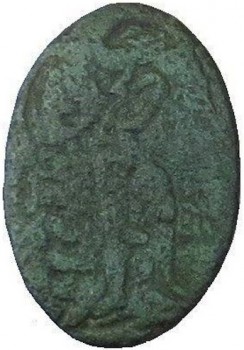
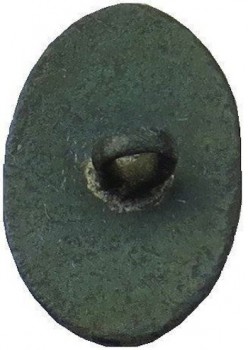
1776-84 MASSACHUSETTS STYLE SWORD-IN-HAND CUFF LINKS-GWI 19
Color: A Light Green.
Metal: Slightly Convex, Oval 1-Piece, Impressed Design, Gilt Brass.
Size: 15.58 x 10.26
Rarity: R-7
Present Condition: An Excavated Specimen, Good Planchet Condition, A Good Impression Remains.
Robert’s Notes: This is an ultra rare specimen of a dress cuff link that pays tribute to the patriots who are fighting in the American Revolution. The button is very reminiscent to Massachusetts State Motif Sword-in-Hand buttons or Paul Revere’s Sword-in-hand Colonial currency note issued in 1776. This rare cuff was probably made sometime during the early days of the American Revolution for a wealthy patriot. My best educated guess would be between 1775-79, and not later. There are at least three known dug specimen that I know of. The button’s pattern depicts a Patriot sitting /leaning on a Cannon with a Saber in his right hand. It appears his body is in a position showing himself as getting ready to charge.
Reverse Button Analysis: This is a one-piece button with a loop shank. The shank looks original, straight, and intact.
Here is another specimen with a cleaner image:
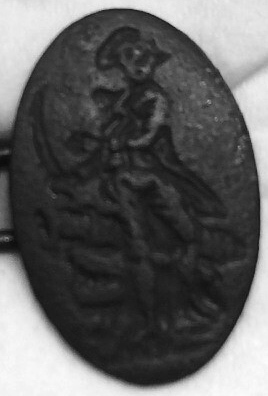
Library Records Has Limited Information on PTP 0-1:
History: Yes Recorded Sales Price: Yes
Current Button Owner and Location: ~ New York ~
Steven Kiss Collection
Previously, The Isabela Collection.~
Dug by Ken Lembo in New Jersey
The Lower Specimen was Dug by Tana
Found in a Plow Field in a known Revolutionary Settlement in .
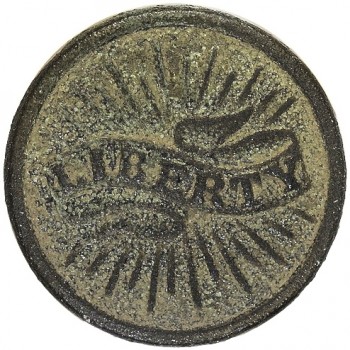
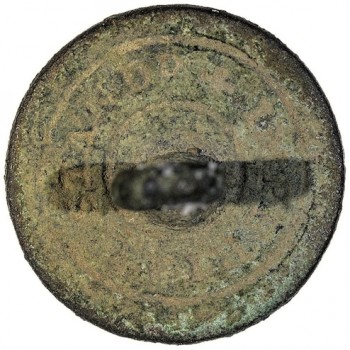
LIBERTY SUNBURST 1790-1810
Color: Street Grey
Metal: Flat, 1-Piece, High Relief Design,
Size: 14mm. Cuff Size
Variety Type: Libert Sunburst
Present Condition: An Excavated Specimen, Strong Planchet Condition, A Strong High Relief Pattern Remains.
Obverse Button Analysis: The patriot slogan for freedom, “LIBERTY” is depicted in Ribbon in high relief Roman font capital letters. There appears to be a Sunburst emanating toward the edge. There is a raised edge guard circling the pattern. We believe the Ribbon Design is a later Francis Shallus signature style.
Reverse Button Analysis: This is a flat one-piece button with a soldered on loop shank. The shank is original, straight and intact.
Library Records Has Limited Information on PTP 1:
History: Yes Recorded Sales Price: Yes
Current Button Owner and Location: ~ California ~
Picture Courteous of Dana L. of E.A.A.
INDEPENDENCE UNITY PROSPERITY 13 STAR SUNBURST
Color: Golden Yellow
Metal: Flat, 1-Piece, High Relief Design,
Size: mm. C Size
Variety Type: 13 Stars, Sunburst,
Present Condition: An Excavated Specimen, Strong Planchet Condition, Strong High Relief Pattern Remains.
Obverse Button Analysis: The True meaning behind this button is where “Three Roads Meet” in Post-Revolution America for prosperity. also tied into GWI 4-B hand chased 3 touch marks. Independence should be sees as Industry.
Reverse Button Analysis: This is a flat one-piece button with a soldered on loop shank. The shank is original, straight and intact.
Library Records Has Limited Information on PTP 2:
History: Yes Recorded Sales Price: No
Current Button Owner and Location: ~ Colorado ~
The B. Moore Collection.

Charles I Liberty Tree Button for the Stamp Act
(Later Reproduction)
Color: Gold.
Metal: Flat, 1-Piece, Impressed Design, Gilt Brass.
Size: 25mm.
Present Condition: A Non Excavated Specimen, Mold Casting, A Strong Impression Remains.
Isabela’s Notes: The button’s depicts a Large Oak Tree in the center with the word “LIBERTY” above. Circling around the outside edge is a Floral Leaf pattern. The buttons has an impressed design on a plain flat field. The symbolic nature of the button was a “Re-purposed” propaganda symbol to defy the taxation of paper products by the Stamp Act of 1765. The symbolism actually comes from an earlier period from Scotland. This is the Stuart history of King Charles I & Charles II. When they took Charles I head, Prince Charles II hid in an old hallowed-out Oak Tree on his property before he escaped to France.
In 1689, Sir Edmund Andros the governor of the dominion of New England under the direction of King James II started seizing all the previously issued land grant charters originally issued by Charles I. A well organized provincial militia formed in the town of Boston which was the capitol at that time of the dominion. What has come to be known as, “The Boston Revolt of 1689,” It is believed that the citizens would meet-up at the “Elm Tree” (not an Oak) that grew in the Boston commons, and join ranks with the provincial militia that was banding together from the colonies.
The Connecticut charter permitted the colony to make some of it’s own rules and elect certain governing officials. Colonial leader Robert Treat (1624-1710) who was born in Somerset, England and at 15 years old he migrated with his family to Massachusetts. His family was a pseudo-benefactor of the King Charles I’s charter. Treat later settled in Milford, CT and then became the leader of the New Haven Colony and ultimately, the governor of Connecticut. When Sir Edmond Andros started stripping away land charters under the authority of King James II, it was seen as a direct attack upon the gentry class’s economic and political sovereignty rights of the original charter. The gentry class would loose political and economic power. When Sir Edmund Andros met with the elected leaders of Connecticut’s colony they refused to give up their charter, and openly call for defiance against Andros.
So, the story goes that there was some kind of “confusion” at the meeting, and with a slight-of-hand the Charter disappeared, and was hidden inside a White Oak Tree for two years until James II was overthrown in 1689, and Andros lost power in the colonies. In the two years Connecticut Connecticut became part of the Dominion of New England, Treat’s rebellious attitude with the Gentry class of supporters, and his prestigious militia officer standing openly call for rebellion. Personal note: He was hailed as a great Indian fighter which carried a lot of weight concerning the safety of the colonists.
Robert J. Silverstein Symbol opinion:
Chestnut Tree – Elm Tree – Oak Tree ? It just doesn’t matter what tree is on the button. This is “Re-purpose” propaganda which give a message of rebellion against the Crown.
Since, the construction of the button could not date back to 1689, I believe this Oak Tree symbol and what it represents in Scottish history for Charles I & Connecticut was re-used in the propaganda war waged by the Jacobites in rebellion of the Stamp Act of 1765. The context of the use would change, but not what the symbol represents. In my opinion, this would be one of the first Propaganda symbols that would be re-used by rebellious Jacobite patriots. Along with Benjamin Franklin’s 8 segmented snake.
Reverse Button Analysis: This is a one-piece button with a loop shank. The shank is original, straight, and intact.
Library Records Has Limited Information on PTP 3:
History: Yes Recorded Sales Price: Yes
Current Button Owner and Location: ~ New York ~
The RJ Silverstein Collection.
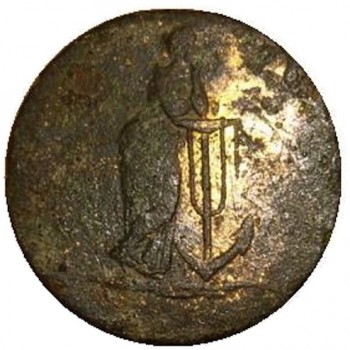
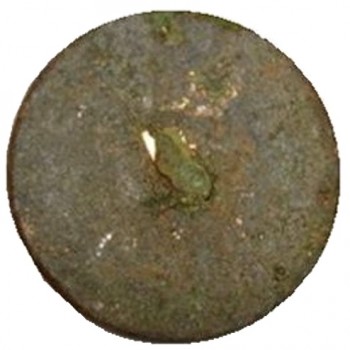
1790’s GODDESS OF HOPE MOTIF COAT BUTTON
Color: An Ochre of Greens and Browns with Patches of Gilt.
Metal: Flat, 1-Piece, Impressed Design, Gilt Brass.
Size: 24mm. Coat Size
Variation: Goddess of Hope Resting / Large Upright Anchor / Long Flowing Gown / Liberty Crown/Cap on Her Head.
Present Condition: An Excavated Specimen, Strong Planchet Condition. Strong Impression Remains.
Robert’s Notes: I was able to date this British cuff button to the 1790’s. The button’s pattern depicts the Goddess of Hope Resting on top of a Large Upright Anchor that is resting on the ground. Just as the coat die variant size, Goddess of Hope is Facing Left, and her hand appears to be under her chin as if she was in contemplation of an idea or thought, or just staring out to sea. She is wearing a Long Flowing Gown with possibly a Liberty Cap/Crown on Her Head. The pattern is impressed in a plain flat oval brass planchet that was finished in gilt.
Reverse Button Analysis: This is a one piece button with a loop shank. The Shank is broken off.
Library Records Has Limited Information on PTP 4:
History: No Recorded Sales Price: No
Current Button Owner and Location: ~ Connecticut ~
The Dale Hawley Collection.
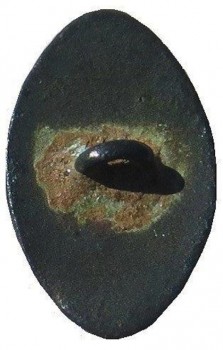
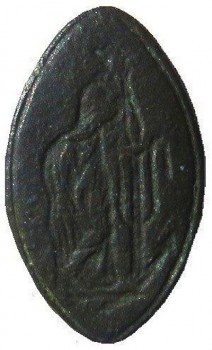
1790’s BRITISH GODDESS OF HOPE CUFF BUTTON
Color: A Dark Seaweed Green.
Metal: Flat, 1-Piece, Impressed Design, Gilt Brass.
Size: 18.19 x 11.06 Oval Cuff Size
Variation: Goddess of Hope Resting on top of a Large Upright Anchor / Facing Left / Decorative Border.
Present Condition: An Excavated Specimen, Strong Planchet Condition. Strong Impression Remains.
Robert’s Notes: I was able to date this Navy Motif cuff button to the 1790’s by using other published memorabilia that carries the same pattern. Most likely British made, but unknown maker. The button’s pattern depicts the Goddess of Hope resting on top of a Large Upright Anchor that is resting on the ground. Just as the coat die variant size, Goddess of Hope is Facing Left, and her hand appears to be under her chin as if she was in contemplation of an idea or thought, or just staring out to sea. She is wearing a Long Flowing Gown with possibly a Liberty Cap/Crown on Her Head. The pattern is impressed in a plain flat oval brass planchet with a Decorative Impressed Border. that was finished in gilt.
Reverse Button Analysis: This is a one piece button with a loop shank. The shank is original, straight, and intact.
Library Records Has Limited Information on PTP 5:
History: Yes Recorded Sales Price: Yes
Current Button Owner and Location: ~ New York ~
The RJ. Silverstein Collection.
1790’s BRITISH GODDESS OF HOPE CUFF BUTTON
Color: A Chestnut Brown Patina.
Metal: Flat, 1-Piece, Impressed Design, Gilt Brass.
Size: 15.90 x 11.22 Oval Cuff Size
Variation: Goddess of Hope Resting on top of a Large Upright Anchor / Facing Right / Liberty Crown/Cap on Her Head.
Present Condition: An Excavated Specimen, Strong Planchet Condition, A Strong Impression Remains.
Robert’s Notes: This is the third die variant that I found for this dress Naval Motif Cuff button. The button’s true maker is still in question. As with the other style, it was only made in limited quantities. The button’s pattern depicts the Goddess of Hope on top of a Large Upright Anchor that is resting on the ground. Unlike the coat variant, the Goddess of Hope is Facing Right, and her hand appears to be under her chin as if she was in contemplation of an idea or thought, or just staring out to sea. She is wearing a Long Flowing Gown with possibly a Liberty Cap/Crown on Her Head. The pattern is impressed in a plain flat oval brass planchet that was finished in gilt.
Reverse Button Analysis: This is a one piece button with a loop shank. The shank is original, and intact, but A little crushed inward.
Library Records Has Limited Information on PTP 6:
History: Yes Recorded Sales Price: Yes
Current Button Owner and Location: ~ New York ~
The RJ. Silverstein Collection.

1793-95 LIBERTY & SECURITY CUFF LINKS
Color: A Silvery Gray Patina.
Metal: Slightly Convex, Oval 1-Piece, Impressed Design, Silvered Copper.
Size: 6mm. x 18mm.
Rarity: R-5
Present Condition: An Excavated Specimen, Strong Planchet Condition, A Strong Impression Remains.
Robert’s Notes: This is a superb example of Federal 18th century cuff links. This was made most likely around Washington’s second inauguration. The button’s pattern depicts a Federal Eagle clutching an Olive Branch in the right talon, and a small bundle of Three Arrows in the left talon. The Eagle is surmounting a crude style Federal Shield. Most likely this would be classified as a Celebratory Button for a New Nation. This was worn during Washington’s administration by someone possibly in a state or federal government position.
Reverse Button Analysis: This is a one-piece button with a loop shank. The shank looks original, straight, and intact.
Library Records Has Limited Information on PTP 7:
History: Yes Recorded Sales Price: Yes
Current Button Owner and Location: ~ X ~
Excavated in 1990’s in Connecticut.~
The Dale Collection.

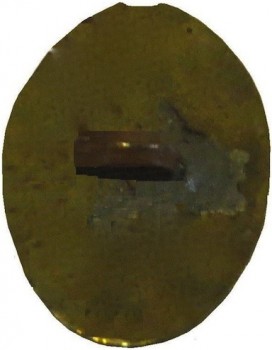
1793-95 FEDERAL SCOTTISH-TRIBUTE DRESS CUFF LINKS
Color: A Brass Yellow.
Metal: Slightly Convex, Oval 1-Piece, Impressed Design, Brass.
Size:
Rarity: R-5
Present Condition: A Non Excavated Specimen, Strong Planchet Condition, A Strong Impression Remains.
Robert’s Notes: This is a superb example of Federal Style 18th century dress cuff links. This was made most likely in Washington’s administration. The button’s pattern depicts a Federal Eagle clutching an Olive Branch in the right talon, and a small bundle of Three Arrows in the left talon. The Eagle has a crude style Federal Shield over it’s chest. This most likely was worn at state official functions.
Reverse Button Analysis: This is a one-piece button with a loop shank. The shank looks original, straight, and intact.
Library Records Has Limited Information on PTP 7-B:
History: Yes Recorded Sales Price: Yes
Current Button Owner and Location: ~ New Jersey ~
George Washington Funeral Portrait Shell Badge
1800
Victor Sine Clade
Nicholas Pierce / Dudley A. Tyng
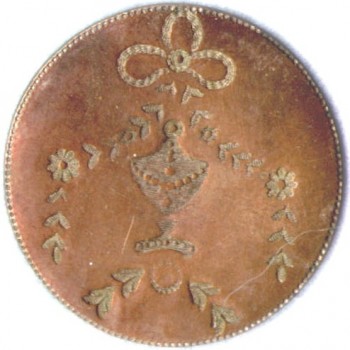
1799 GEORGE WASHINGTON MEMORIAL BUTTON
Color: Coppery Red.
Metal: Flat, 1-Piece, Impressed Design, Silvered Copper.
Size: 34.60mm 109.8 Grns.
Present Condition: A Non Excavated Specimen, Strong Planchet Condition, An Exceptional High Relief Pattern Remains.
Rarity: R-7
Isabela’s Notes: This is a George Washington large inauguration size Mourning Button. There is only three of these I know of, but there maybe a few more out there. The button is the same large 35mm size that was produced by the English artisans for George Washington’s inauguration. The button’s pattern depicts a Stippled Funeral Urn in the center. On each side there are Two Flowers with Eight Petals that form a drooping vine. These two vines are draped from a top circular ornamentation. This ornamentation is what i believe to be an ancient Anglo-Saxon Merovingian symbol. The button shows roughly 150 Impressed Stipples around the border’s edge. This button must have been tinned or silvered from trace evidence on the reverse.
Reverse Button Analysis: This is a flat one-piece button with a loop shank. The shank is original, straight, and intact.
Library Records Has Limited Information on PTP 8:
History: Yes Recorded Sales Price: Yes
Current Button Owner and Location:
Dug in South Berwick, Maine.
Bought by Joseph Sawicki then sold to H. Cobb.
*Published and Plated in “Just Buttons” in March , 1965.
Picture Courteous of Kirk mitchell.
Robert’s Notes: The button definitely shows the craftsmanship work of the English guild artisans. My conclusion is based on the button’s stipple work and evenly lined fields. This craftsmanship is repeatedly shown in late 18th Century English-made guild produced buttons. What interests me is the circular ornamentation of the Three Petals with the raised Stipple center. There are three conclusions I have. First, this is an Irish George Washington Mourning button. The three petal Shamrock (Sprig-clover) is the renowned symbol for Ireland. Saint Patrick was said to have used it as a metaphor for the Christian Trinity. The downside is there is no Irish relationship ties to George Washington. The second idea maybe the strongest. Dale was able to provide me with some evidence in another artifact that it is an Anglo-Saxon design indicating that Washington might have a Merovingian bloodline tie. He claims there was a lot of intermingled family history. The three circle symbol being English can also be supported with another English-made button I own which has the inscription that supports the English Crown ( King & Constitution button section). The last theory is the Scottish Union Jack. As with most George Washington inaugural buttons there is Strong Scottish Royal family symbolism layered within. The three circular petals could represent a union jack, and mean the sympathy of Scotland, England, and Ireland. We also have 8 Petals could be the union jack of the two patron saints of Scotland (X) and England (+). All three of my theories have merit, and my goal is only to present the evidence from my years of study into symbolism. Not give definitive answers.
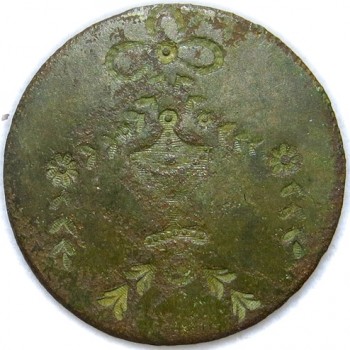

1799 SCOTTISH STYLE GEORGE WASHINGTON MEMORIAL BUTTON
Color: An Earth Tone Green.
Metal: Flat, 1-Piece, Impressed Design, Silvered Copper.
Size: 34.56mm
Present Condition: An Excavated Specimen, Good Planchet Condition, A Strong High Relief Pattern Remains.
Rarity: R-7
Isabela’s Notes: This is a George Washington large inauguration size Mourning Button. There is only three of these I know of, but there maybe a few more out there. The button is the same large 35mm size that was produced by the English artisans for George Washington’s inauguration. The button’s pattern depicts a Stippled Funeral Urn in the center. On each side there are Two Flowers with Eight Petals that form a drooping vine. These two vines are draped from a top circular ornamentation. This ornamentation is what i believe to be an ancient Anglo-Saxon Merovingian symbol. The button shows roughly 150 Impressed Stipples around the border’s edge. This button must have been tinned or silvered from trace evidence on the reverse. .
Reverse Button Analysis: This is a flat one-piece button with a loop shank. The shank is original, straight, and intact.
Library Records Has Limited Information on PTP 8:
History: Yes Recorded Sales Price: Yes
Current Button Owner and Location: ~ New York~
*Published and Plated in “Just Buttons” in March , 1965.
Excavated in UxBridge, Massachusetts by Ray Grenier.
The RJ. Silverstein Collection.
Link : 1799 George Washington Mourning Button-Scot Mark
Robert’s Notes: The button definitely shows the craftsmanship work of the English guild artisans. My conclusion is based on the button’s stipple work and evenly lined fields. This craftsmanship is repeatedly shown in late 18th Century English-made guild produced buttons. What interests me is the circular ornamentation of the Three Petals with the raised Stipple center. There are three conclusions I have. First, this is an Irish George Washington Mourning button. The three petal Shamrock (Sprig-clover) is the renowned symbol for Ireland. Saint Patrick was said to have used it as a metaphor for the Christian Trinity. The downside is there is no Irish relationship ties to George Washington. The second idea maybe the strongest. Dale was able to provide me with some evidence in another artifact that it is an Anglo-Saxon design indicating that Washington might have a Merovingian bloodline tie. He claims there is a lot of intermingled family history. The three circle symbol being English can also be supported with another English-made button I own which has the inscription that supports the English Crown ( King & Constitution button section). The last theory is the Scottish Union Jack. As with most George Washington inaugural buttons there is strong Scottish Royal family symbolism layered within. The three circular petals could represent a union jack, and mean the sympathy of Scotland, England, and Ireland. We also have 8 Petals could be the union jack of the two patron saints of Scotland (X) and England (+). All three of my theories have merit, and my goal is only to present the evidence from my years of study into symbolism. Not give definitive answers.


PRE-1800 EARLY MEMORIAL BUTTON SCOTTISH-ROMAN STYLE ( French Tassel Design)
Color: A Milk Chocolate Brown.
Metal: Flat, 1-Piece, Impressed Design, Copper.
Size: 25mm
Present Condition: An Excavated Specimen, Good Planchet Condition, A Strong Impression Remains.
Rarity: R-6
Robert’s Notes: This is a Scottish Roman Style Mourning Button with the Toasting Chalice. I only know of two buttons with this same Roman style Chalice Toasting Glass line structure. The button’s pattern depicts a Funeral Urn that has a Lower Portion as a Roman Style Toasting Chalice. Sort of celebratory style funeral of the era. Two French style Tassels flank the sides of the challis. Incuse exterior ring. Pyramid Shape Border.
Reverse Button Analysis: This is a flat one-piece button with a loop shank. The shank is broken off.
Library Records Has Limited Information on PTP 8-A:
History: No Recorded Sales Price: No
Current Button Owner and Location: No


1799/1800 SCOTTISH ARTISAN ROMAN STYLE GW MOURNING BUTTON
Color: An Olive Green With Rusty Orange Pattern Highlights.
Metal: Flat, 1-Piece, Impressed Design, Gilt Brass.
Size: 20.14 x 14.75 mm.
Present Condition: An Excavated Specimen, Strong Planchet Condition, A Strong Impression Remains.
Rarity: R-7
Robert’s Notes: The button depicts a Wine Glass Shape Urn. The urn appears to be two separate type cups with a wiggle line and stipples in the middle a separator. The wiggle line appears to be a Snake with the head to the right. The bottom section of the urn appears to be a Roman Style Drinking Chalice which was commonly used for Toasting Celebratory events of the deceits life. The Chalice depicts 13 distinct ribs or lines with 3 evenly spaced Stipples in tribute to Scotland, England, Ireland above. The symbol at the top of the urn looks like a Honey Bee with two eyes. The bottom half is a break-away for a toasting challis. Funerals usually involved mourning for 3 or more days because of travel. The cup of the Chalice has 7 lines to probably commemorate education of the Liberal Arts or a tribute to the 7 Earls of Scotland.
Reverse Button Analysis: This is a flat one-piece button with a loop shank. The shank is original, straight, and intact.
Library Records Has Limited Information on PTP 8-B:
History: Yes Recorded Sales Price: Yes
Current Button Owner and Location: Yes
The RJ Silverstein Collection.
Dug by J.H. at Sackets Harbor.


1799/SCOTTISH STYLE GEORGE WASHINGTON MEMORIAL BUTTON
Color: Pewter Grey.
Metal: Slightly Convex, 1-Piece, Raised Motif, Impressed Ornamental Design, Copper.
Size: 24mm
Present Condition: An Excavated Specimen, Good Planchet Condition, A Strong Impression Remains.
Rarity: R-2
Isabela’s Notes: This is another variation of a George Washington Mourning Button. The button’s pattern depicts a Funeral Urn in high relief against an evenly lined field background.
Reverse Button Analysis: This is a flat one-piece button with a loop shank. The shank is original, straight, and intact.
Library Records Has Limited Information on PTP 8:
History: No Recorded Sales Price: No
Current Button Owner and Location: ~ X ~
The D. Hawley Collection.
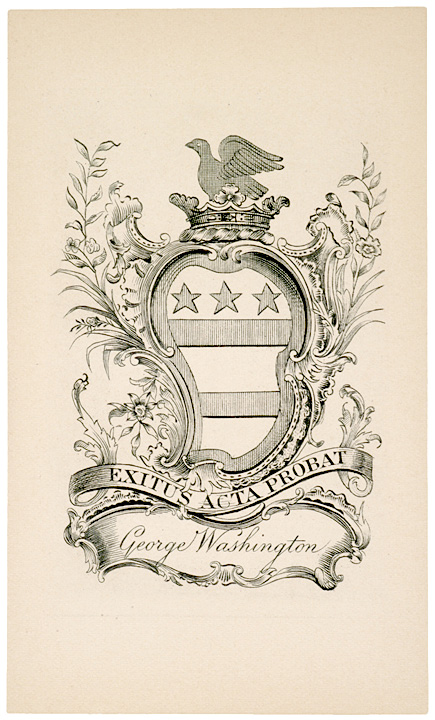
In my research, I have come to conclude there are only 3 styles of Mourning Cuff designs made for George Washington’s funeral in 1799. The first is Scottish, and like the 1789 inaugural buttons it is much larger then coat size (35mm). This is made with Scottish Tribute symbols, and has a Celtic knot surmounting the cover of the urn. The second is a cuff button variant made with a crowning dove. Above is Washington’s personal bookplate to cross-match my personal theory. The third, is Scottish, and also and is the rarest design. This button depicts a Roman Chalice with a Lavish Urn topper above a snake and three stipples. Collectors should note, when buying advertised GW urn style buttons that it was customary for years before and after Washington’s death to sell this style button. It is a mistake for collectors to buy publicized GW morning buttons out of these three known confirmed styles! An 18th century Urn button doesn’t make it Washingtons!! No matter how ornate. – Robert
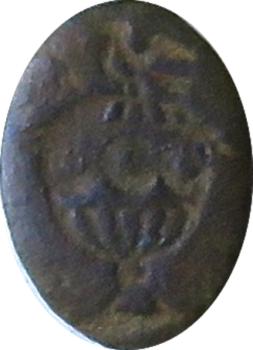
Washington Eagle Surmounting Urn Button
This Pattern was Specifically Made for George Washington
* RJ Silverstein Collection *

1799/1800 DOVE GEORGE WASHINGTON FUNERAL URN WITH EAGLE
Color: A Coppery Brown
Metal: Slightly Convex, Oval 1-Piece, Impressed Design, Gilt Brass.
Size: 6mm x 16mm. cuff Size.
Present Condition: An Excavated Specimen, Strong Planchet Condition, A Good Impression Remains.
Variation: Thinner Urn / Infinity Design / Thinner Body Eagle / Longer Urn Cover / Stipple Top Stem.
Robert’s Notes: This is a Washington morning cuff button with surmounting Eagle. This button is rarely ever seen, and they are usually never offered for sale in the market place. I did some research into old newspaper advertisements & articles and found that this pattern was made specifically for George Washington when he passed. With some more research he was able to link this motif to other artifacts in porcelain. This button crudely depicts an Eagle standing on an Urn. Unlike the large inaugural style mourning button, this appears to be American made.
Reverse Button Analysis: This is a flat one-piece button with a loop shank. The shank is original, straight, and intact.
Library Records Has Limited Information on PTP 8:
History: Yes Recorded Sales Price: Digger Owner
Current Button Owner and Location: ~ Massachusetts~
Excavated on the Massachusetts/ Connecticut Border.~
The Dale Collection.

1799/1800 DOVE GEORGE WASHINGTON FUNERAL URN WITH EAGLE
Color: A Coppery Brown
Metal: Slightly Convex, Oval 1-Piece, Impressed Design, Gilt Brass.
Size: 9mm x 18mm. Cuff Size.
Present Condition: An Excavated Specimen, Good Planchet Condition, A Good Impression Remains.
Variation: Broad Urn / Circle Design / Fuller Breast Eagle / Smaller Urn Cover / Ball Top Stem.
Robert’s Notes: This is another pattern made for George Washington mourning. This mourning cuff button also has the surmounting Eagle on a wider Urn. This button is rarely ever seen, and they are usually never offered for sale in the market place. I did some research into old newspaper advertisements & articles and found that this pattern was made specifically for George Washington when he passed. With some more research he was able to link this motif to other artifacts in porcelain. This button crudely depicts an Eagle standing on an Urn. Unlike the large inaugural style mourning button, this appears to be American made.
Reverse Button Analysis: This is a flat one-piece button with a loop shank. The shank is original, straight, and intact.
Library Records Has Limited Information on PTP 8:
History: Yes Recorded Sales Price: Yes
Current Button Owner and Location: ~ New York ~
The Robert J. Silverstein Collection.
There is so much varied interpretations of the dove, it becomes relevant where you see it as in which culture or even which country. Generally it is thought of in the Christian world as the soul or even purity and is most associated with femininity. That would contradict the Washington funeral cuff pieces unless you are familiar with competing symbolism – allusions.-Dale Hawley.
Society of Cincinnati Club Medal Owned by General Nathanael Greene, Smithsonian, Washington, D.C.
Ribbon Was Red, White, & Blue. Gold Embellished with Emeralds.


FOLK ART CUFF LINK PORTRAIT OF WASHINGTON WEARING A ROMAN STYLE TOGA
Color: A Silvery Gray Patina.
Metal: Flat, Oval 1-Piece, Raised Design, Solid Silver.
Size: 18mm x 14mm.
Rarity: R-7
Present Condition: A Non Excavated Example, Exceptional Planchet Casting, Exceptional Impressions.
Robert’s Notes: This is a Folk-Art Style portrait of George Washington. He is wearing a Roman Style Toga, and a Laurel Wreath of Victory upon his head. This pattern is similar to the 1783 Georguis Triumpho tokens and coins which pay homage to Washington’s victory over the British. There is an Archaic Style Lettering for Gen. Washington. This was most likely a British Manufactured cuff link for an American Market.
Reverse Button Analysis: Slightly convex one-piece button with loop shank. The shank looks original, straight, and intact.
Library Records Has Limited Information on PTP 9:
History: Yes Recorded Sales Price: Yes
Current Button Owner and Location: No
~ Hail Columbia was George Washington’s official Inaugural Anthem by Philip Phile ~
HAIL COLUMBIA BUTTON – EAGLE WITH LIBERTY SHIELD AND 13 STARS
Color: A Golden Brass Brown.
Metal: Flat, 2-Piece, Raised Design, Brass
Size: 34.92mm
Rarity: R-6
Present Condition: A Non Excavated Button, Exceptional Planchet Casting, Exceptional Impressions.
Isabela’s Notes: This is most likely a patriotic, or commemorative 19th century button. Columbia was the poetic name for the United States during the 18th Century. In 1789, Philip Phile a composer with the help of lyricist Joseph Hopkinson composed an Anthem called, “The Presidents March.” This was composition was used for the inauguration of George Washington. This musical piece would be the same as “Hail to the Chief “ that is for later presidents The Anthem was used up through the 19th Century, but then lost it’s popularity after World War I. In 1931, the anthem was officially replaced by The Star Spangled Banner. This was a more popular choice which carried a greater sentiment for the American public. The new Anthem was written by a 35 year old lawyer, and amateur poet, Frances Scott Keys in 1814. The lyrics comes from him watching as a bystander the defense of Fort McHenry. The original anthem Hail Columbia was not completely phased out. It is still used during slow marches of military ceremonies, and is currently the anthem that is played for the Vice President of the United States.
Reverse Button Analysis: This is a two-piece button with a loop shank. The original shank is straight, and intact. The surface shows a few nicks and scratches.
Robert’s Notes: To Listen to the Anthem Hail Columbia on You tube: http://www.youtube.com/watch?v=tfbiw6vhYiQ
Library Records Has Limited Information on PTP 10:
History: Yes Recorded Sales Price: Yes
Current Button Owner and Location: ~ Idaho ~
Button purchased in Tennessee.~
Peg’s Buttons, Part of the Purple Collection.. lol~


1758 SPANISH CONVERTED COIN TO BUTTON
Color: Pewter Grey with Green Encrustations.
Metal: Flat 1-Piece, Raised Design, Reported Pewter. (Copper)?
Size: 27.5mm.
Present Condition: An Excavated Specimen, Strong Planchet Condition, A Strong High Relief Pattern Remains.
Robert’s Comments: This type of converted coin has been found in some numbers, usually around some Revolutionary War sites and trails. Most are cast from period coins, and they have no official military connections as far as issue. One theory put forth is that some America Militia, or Civilians that helped in the war effort wore some of these along with other civilian or plain buttons. This example is better then most, and still has a clear image of the design.
Reverse Button Analysis: The Boss is still present, but the loop shank is broken off.
Robert’s Notes: The uniforms that Spain provided us in the Revolution were not in fact from Spanish origin, they were British uniforms that came from a transport they had captured. At that time, Spain did have the 3rd largest Navy, and they did help us; but Spain did not have military buttons until way after the revolution.
Library Records Has Limited Information on PTP 11:
History: Yes Recorded Sales Price: Digger Owner
Current Button Owner and Location: ~ X ~
Excavated on the Connecticut/Massachusetts border.~
The Dale Collection.


LAFAYETTE GOLD RELIEF PRESENTATION BUTTON
Robert’s Notes: General Lafayette proved to be an excellent military general, and was known to be a person of high moral fiber with good character. He was not just a hero to one country, but a hero two nations that had overcome British Tyranny. When the American Revolutionary War ended, and he returned to his home country of France, where he was welcomed as national hero in the light of liberty, freedom, equality, and justice. When Lafayette traveled back to America in 1784, he returned as a triumphant war hero for the American people. He did visit his close friend George Washington at Mount Vernon. He addressed the house of Delegates, and prayed for the “Liberty of All Man Kind” and urged the importance of emancipation. In Pennsylvania he urged the importance to the legislature for a Federal Union. He also visited the Mohawk Valley in New York, and intervened for peace with the Iroquois Indians. Harvard University bestowed an honorary degree, the city of Boston gave him a portrait of his good friend Washington, and he got a bust from the state of Virginia. Connecticut, Massachusetts, Maryland, and Virginia granted him honorary citizenship. During the French Revolution, Lafayette took the side of freedom. In 1789, he presented a draft of the declaration of the rights of man, and the french citizen. He sat in the National Assembly as a constitutional Royalist, and was persecuted by the Jacobins and was sentenced to an Australian prison for six years before being released by Napoleon. In 1824 President James Monroe invited him to visit the United States as part of the nations 50th Anniversary celebration. From the moment he arrived in New York’s harbor, the people ran to the shores lines hailing him, and blessing his return to America. A real hero’s welcome. He visited 24 states, and the enthusiasm of the people was repeated in every town and city. In the words of James R. Gaines,”Lafayette is the embodiment of all America had been through and accomplished and would become.”


JACKSON POLITICAL REVERSE CUFF BUTTON
Color: A Dark Olive Green.
Metal: Flat, 1-Piece, Impressed Design, Gold-Wash Brass.
Size: 15mm. Cuff Size.
Present Condition: A Non Excavated Specimen, Strong Planchet Condition, A Strong Impression Remains.
Isabela’s Notes: T
Reverse Button Analysis: This is a one-piece button with a loop shank. The shank is original, straight, and intact.
Library Records Has Limited Information on PTP 12:
History: Yes Recorded Sales Price: No
Current Button Owner and Location:


JACKSON POLITICAL REVERSE CUFF BUTTON
Color: Antiqued Silver.
Metal: Flat, 1-Piece, Impressed Design, Silvered.
Size: 20mm. Coat Size.
Present Condition: A Non Excavated Specimen, Strong Planchet Condition, A Strong Impression Remains.
Isabela’s Notes: T
Reverse Button Analysis: This is a one-piece button with a loop shank. The shank is original, straight, and intact.
Library Records Has Limited Information on PTP 13:
History: Yes Recorded Sales Price: No
Current Button Owner and Location:
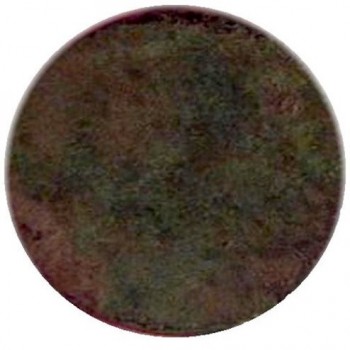
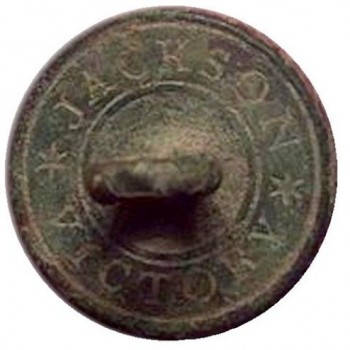
JACKSON POLITICAL REVERSE CUFF BUTTON
Color: A Reddish-Brown.
Metal: Flat, 1-Piece, Impressed Design, Brass.
Size: 15mm. Cuff Size.
Present Condition: An Excavated Specimen, Strong Planchet Condition, A Strong Impression Remains.
Isabela’s Notes: T
Reverse Button Analysis: This is a one-piece button with a loop shank. The shank is original, straight, and intact.
Library Records Has Limited Information on PTP 14:
History: No Recorded Sales Price: No
Current Button Owner and Location: No
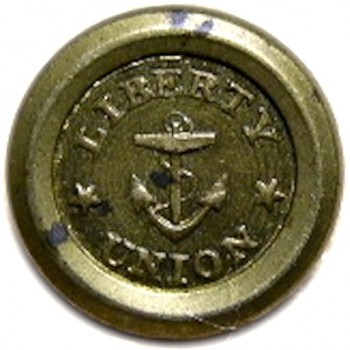
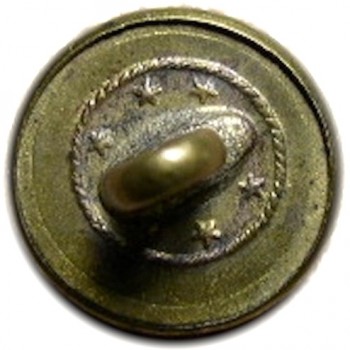
1820’s LIBERTY UNION NAVY JACKSON MILITARY STYLE SUPPORT BUTTON
Color: A Dark Olive Green.
Metal: Flat, 1-Piece, Impressed Design, Gilded Brass.
Size: 15mm. Cuff Size.
Present Condition: A Non Excavated Specimen, Strong Planchet Condition, A Strong Impression Remains.
Isabela’s Notes:
Reverse Button Analysis: This is a one-piece button with a loop shank. The shank is original, straight, and intact.
Library Records Has Limited Information on PTP 15:
History: No Recorded Sales Price: Yes
Current Button Owner and Location: ~ New Jersey ~
J. Dews Collection.


1820’s DROOP WING EAGLE JACKSON MILITARY STYLE SUPPORT BUTTON
Color: Silver With Brown Undertones.
Metal: Flat, 1-Piece, Impressed Design, Silvered.
Size: 15mm. Cuff Size.
Present Condition: A Non Excavated Specimen, Strong Planchet Condition, A Strong Impression Remains.
Isabela’s Notes: T
Reverse Button Analysis: This is a one-piece button with a loop shank. The shank is original, straight, and intact.
Library Records Has Limited Information on PTP 16:
History: Yes Recorded Sales Price: No
Current Button Owner and Location: No
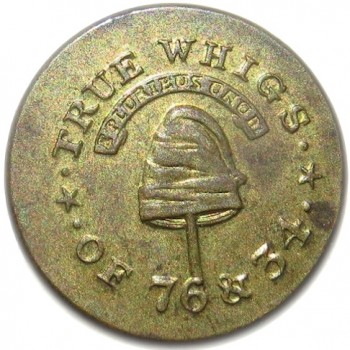

1834 True Whigs of 76 & 34
Color: Metallic Gold With Brown Undertones.
Metal: Flat, 1-Piece, High Relief Design, Gilt Brass.
Size: 17.10mm. Cuff Size.
Albert’s : PC 96 A-1
Present Condition: A Non Excavated Specimen, Strong Planchet Condition, A Strong High Relief Pattern Remains.
Isabela’s Notes: This political button was manufactured in England. The button depicts a Phrygian Cap on a Liberty Pole. Arced along the top in raised letters is the political party, “TRUE WHIGS.” These raised letters surmount a banner ribbon inscribed with, “E. PLURBUS UNUM” in Roman font capital letters. Campaign Date of, “76 & 34” are in raised number in the lower legend. A Star flanked by Two Raised Stipples adorns each side of the legend.
Reverse Button Analysis: This is a one-piece button with an omega shank. The shank is original, straight, and intact.
Library Records Has Limited Information on PTP 17:
History: Yes Recorded Sales Price: Yes
Current Button Owner and Location: ~ New York ~
The RJ Silverstein Collection.
